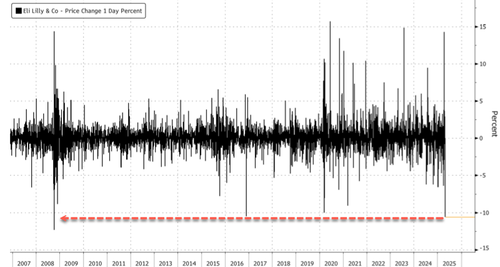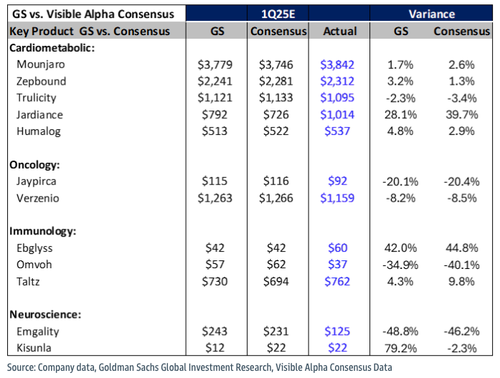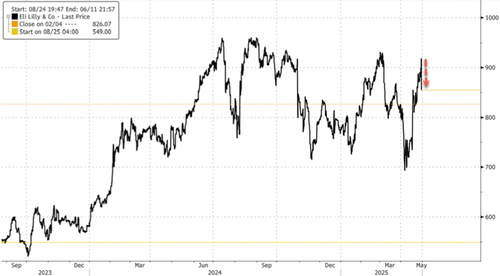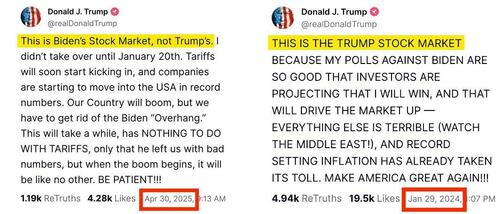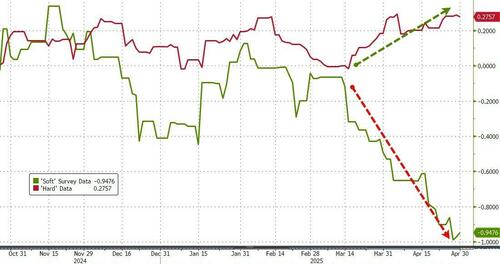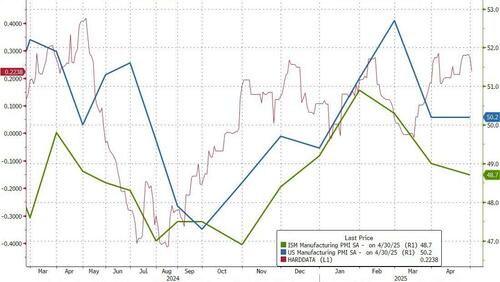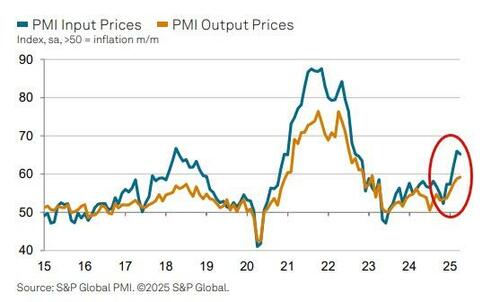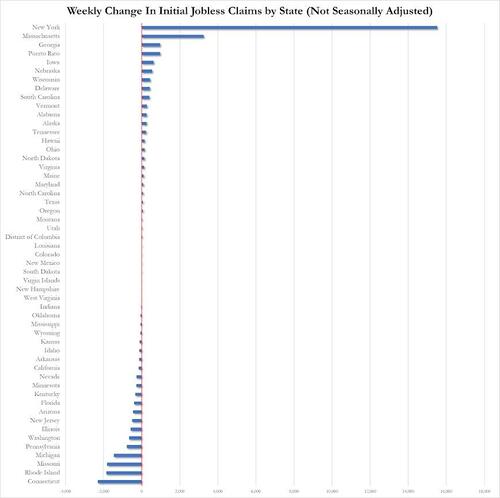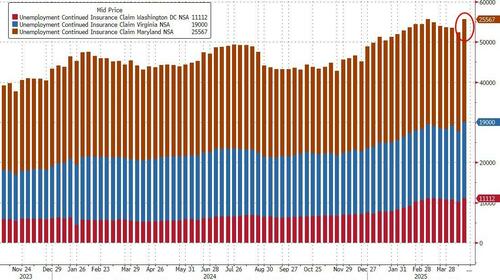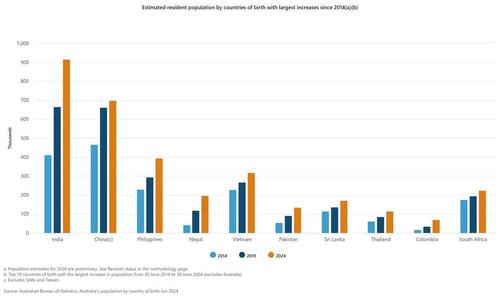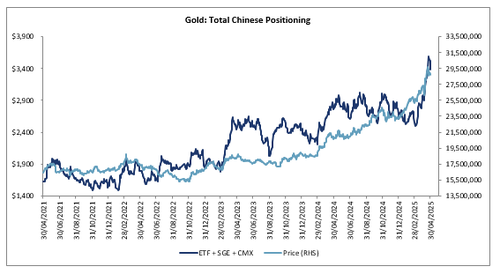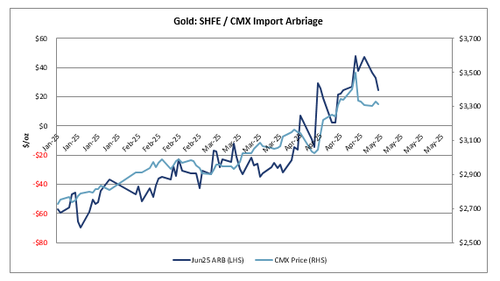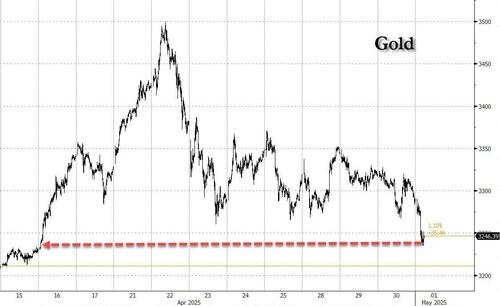The Eucharist is "the source and summit of the Christian life."
Distinction Matter - Subscribed Feeds
-
Site: LES FEMMES - THE TRUTH
-
Site: LifeNews
Another East Texas county has passed an ordinance outlawing abortion. Camp County (pop. 13,039) passed their ordinance on Wednesday morning, becoming the 10th city in the nation to pass such a measure.
The measure, which was presented by Right to Life Across Texas, was passed in a unanimous 5-0 vote by Judge A.J. Mason and County Commissioners Jed Hefner, Tommy Rozell, Perry Weeks, and Steve Lindley.
The vote came after the East Texas city of Avinger passed a similar ordinance on Monday and after a new report was released which found that about 11% of women experience “sepsis, infection, hemorrhaging, or another adverse event within 45 days following a mifepristone abortion.” Judge Mason shared, “I can think of no greater cause to be a part of than defending those who can’t defend themselves. This is a great day.”
Executive Director for East Texans for Liberty Stacy McMahan, shared, “We are eternally grateful to the Camp County Commissioners Court for being the first county in East Texas to unanimously pass a Sanctuary County for the Unborn ordinance. This ordinance aligns with the law to protect the unborn.” McMahan continued, “What many do not understand is that this also protects our youth from being trafficked across state lines for abortions that result in the death of innocent babies. In our area, underage children may find themselves in situations they are afraid to tell their parents about, or they may experience abuse or molestation by family members aiming to conceal evidence of their crime. This all results in the loss of innocent life. Have you seen the sign at the abortion clinic in New Mexico that says, ‘Welcome East Texans…’? It is heartbreaking, and I cannot understand why any county or city would not address this issue promptly.”
HELP LIFENEWS SAVE BABIES FROM ABORTION! Please help LifeNews.com with a donation!
The Camp County Sanctuary County for the Unborn Ordinance extends the private right of action found in the Texas Heartbeat Act from the point of a detectable heartbeat to the point of conception – allowing a lawsuit to be filed against anyone in violation of the ordinance. The ordinance is clear that no action may be brought against the mother of the unborn child upon whom the abortion was performed or induced or attempted to be performed or induced in violation of the ordinance. The ordinance also prohibits the mailing of abortion-inducing drugs into the county, prohibits abortion trafficking through the county, and prohibits waste management companies from trafficking aborted babies through the county or disposing of dead babies anywhere within the county. In addition to providing protections for pregnant mothers and their unborn children, the ordinance also educates about the Thriving Texas Families Program and directs people to the Texas Pregnancy Care Network website and The Pregnancy Network website operated by Human Coalition to be connected to the program’s services.
Upon hearing the news, Texas State Representative Cole Hefner, who represents Camp County, shared, “While I couldn’t be there in person due to session in Austin, I’m incredibly proud to celebrate some powerful news out of Camp County this morning. With a unanimous 5-0 vote, the Commissioners’ Court passed an ordinance officially making Camp County a Sanctuary County for the Unborn — the first in East Texas, the eighth in our state, and the tenth in the entire nation to do so. This bold step not only outlaws abortion within the unincorporated areas of the county, but it also prohibits abortion trafficking and the aiding and abetting of elective abortions—even when those efforts begin or pass through Camp County.”
Hefner continued, “I commend Judge A.J. Mason and the entire Commissioners’ Court for their courage and commitment to protecting the most vulnerable among us. This isn’t just a symbolic statement—it’s a legally enforceable action that honors the sanctity of life and strengthens Texas’ stance as a leader in the fight for the unborn. I’m proud to stand with Camp County as they take a bold stand for life.”
The Sanctuary for the Unborn ordinances, which have now been passed in 57 cities and 8 counties across the state, help to reduce these numbers to the best of their ability. Part of what several counties and cities have accomplished at the local level is being attempted at the state level through bills like the Woman and Child Protection Act (TX HB 5510 / TX SB 2880) and the Stop Tax-Funded Abortion Travel Act (TX SB 33 / TX HB 1806). Those who wish to encourage the Texas legislature to prioritize the passage of such bills can do so by sending the legislature a message through contacting Texas Right to Life. Citizens who are interested in seeing their county or city pass an ordinance going as far as their city or county can to prohibit abortion are encouraged to sign the online petition on the Sanctuary Cities for the Unborn website.
LifeNews Note: Mark Lee Dickson lives in Texas and is the founder of the Sanctuary Cities for the Unborn Initiative.

The post Texas County Passes Law Banning Abortions appeared first on LifeNews.com.
-
Site: Zero HedgeAmazon Announces $4 Billion Rural Delivery Network, Estimates 100,000 New JobsTyler Durden Thu, 05/01/2025 - 15:05
Authored by Naveen Athrappully via The Epoch Times,
Amazon will invest $4 billion by 2026 to expand its network in rural America for delivering packages faster in densely populated areas, the company said in an April 30 statement.
“This investment will also grow our rural delivery network’s footprint to over 200 delivery stations, and we estimate it will create over 100,000 new jobs and driving opportunities through a wide range of full-time, part-time, and flexible positions in our buildings and on the roads,” the company said.
“Once this expansion is complete, our network will be able to deliver over a billion more packages each year to customers living in over 13,000 zip codes spanning 1,200,000 square miles—an area the size of Alaska, California, and Texas combined.”
The effort focuses on small towns in the United States. Amazon plans on expanding at a time when many logistics providers “have backed away from investing in rural customers and communities.”
Amazon estimates that by the end of next year, its rural delivery network will triple in size, with average delivery times being cut in half.
For each new facility opened as part of expansion, an estimated 170 new jobs on average shall be created at the delivery station level, Amazon said, adding that other job opportunities would be extra, such as those created via the Delivery Service Partner (DSP) and Amazon Flex programs.
DSP is a program in which small businesses set up delivery services to transport Amazon goods. Flex is aimed at individuals who want to make some extra money delivering Amazon packages using their own vehicles.
The flex program has been caught up in legal conflicts involving driver contracts.
In June last year, lawyers representing thousands of Amazon Flex drivers announced they filed legal claims alleging the company wrongly classified the drivers as independent contractors rather than employees, which led to them being deprived of various financial benefits and worker protections.
“As Amazon exerts considerable control over the Flex drivers in their deliveries and the deliveries are part of Amazon’s usual business, the drivers qualify as Amazon employees, not independent contractors, and should be paid accordingly,” Joseph Sellers, partner at Cohen Milstein Sellers & Toll PLLC and attorney for the drivers, said at the time.
In an emailed statement to The Epoch Times, an Amazon spokesperson said the Flex program enables individuals to make “competitive pay” while setting their own schedules and being their own boss.
“We hear from most of the Amazon Flex delivery partners that they love the flexibility of the program, and we’re proud of the work they do on behalf of customers every day,” the spokesperson said.
In its April 30 statement, Amazon said it is the leading job creator in the United States, having created more than 500,000 jobs over the past five years.
The company cited a study by Amazon economists, the University of Pennsylvania, and The Wharton School, which found that “when Amazon opens a facility, median household incomes in the county increase by $1,225 per year and poverty rates fall by as much as 3.3 percent on average,” the statement said.
UPS Delivery Cut, Tariff Rumor
Amazon’s decision to expand rural delivery comes as the United Parcel Service (UPS) recently said it was aiming to cut half of its Amazon business by the second half of the year.
During a Jan. 30 earnings call, UPS CEO Carol Tome said the company was concerned about the volume and revenue concentration that was tied up with its Amazon delivery operations.
“Our contract with Amazon came up this year, and so we said it’s time to step back for a moment and reassess our relationship because if we take no action, it will likely result in diminishing returns,” she said.
In an April 29 conference call with Wall Street analysts, Tome said she was pleased with the ongoing efforts to reduce the company’s reliance on Amazon’s business.
“This volume is not a healthy fit for our network. The Amazon volume we plan to keep is profitable and is a healthy volume,” she said, adding that Amazon currently makes up 11.7 percent of UPS revenue.
Meanwhile, Amazon recently responded to a report that it was planning to display the cost of U.S. tariffs next to the price of products on its website.
The report had triggered comments from the White House, with press secretary Karoline Leavitt saying on April 29 that such a move would amount to a “hostile and political act.”
“Why didn’t Amazon do this when the Biden administration hiked inflation to the highest level in 40 years?” she said.
Amazon denied that it would be carrying out the plan, saying it never considered displaying tariff information on its website.
“The team that runs our ultra-low cost Amazon Haul store considered the idea of listing import charges on certain products. This was never approved and is not going to happen,” Amazon spokesperson Tim Doyle said in an emailed statement to The Epoch Times.
-
Site: RT - News
Secretary of State Marco Rubio will take the vacant position in the interim
US President Donald Trump has confirmed that Mike Waltz will leave his position as national security adviser. The president said on Thursday that he would nominate Waltz as the next American envoy to the UN, while Secretary of State Marco Rubio will take over his duties “in the interim.”
“I am pleased to announce that I will be nominating Mike Waltz to be the next United States Ambassador to the United Nations,” Trump said in a post on Truth Social on Thursday as he praised Waltz’s record as an army veteran, a member of Congress, and national security adviser.
The president did not elaborate on whether Waltz had already left his post or would do so in the near future. Instead, he said that Rubio would temporarily fill the position “while continuing his strong leadership at the State Department.” He did not name any potential picks to replace Waltz on a permanent basis.
Read more Trump fires Mike Waltz – Fox
Trump fires Mike Waltz – Fox
Earlier on Thursday, Fox News reported that Waltz had been fired earlier the same day. The broadcaster did not name the reasons for his dismissal but pointed to the role he had played in the so-called ‘Signalgate’ scandal in March.
An editor from The Atlantic magazine had gained access to an internal chat involving senior Trump administration members discussing a strike against Yemeni Houthi militants, prompting the media outlet to run a story about it. The leak was then attributed to Waltz, who mistakenly saved the contact of the journalist under an incorrect name and invited him to the chat. The official later admitted his mistake in an interview with Fox and said he took “full responsibility” for it.
Later on Thursday, Axios reported, citing White House sources, that Waltz had not left his position yet, but is expected to do so in the near future.
Politico identified Trump’s special envoy Steve Witkoff as a “leading pick” to replace Waltz. CNN journalist Alayna Treene claimed, citing her sources close to Witkoff, that he is not interested in taking the position and his team does not expect him to be chosen by Trump.
-
Site: southern orders
Cardinal Provost is being seen as a serious contender as the next pope!NcR reporting (please note what I highlight in RED:
On another front, the idea of an American pope is gaining traction with Cardinal Robert Prevost emerging as a serious frontrunner, NCR's Christopher White and Rhina Guidos reported. Born in Chicago but shaped by decades of service in Latin America and Europe, the 69-year-old Augustinian friar now heads the Vatican office that oversees bishop appointments worldwide.
His blend of pastoral fieldwork and curial experience has drawn attention, particularly as Cardinal Pietro Parolin’s candidacy falters, according to multiple Italian news outlets today, May 1.
The Corriere della Sera also reported Prevost has been seen on April 30 entering conservative U.S. Cardinal Burke's apartment in Rome to take part in "a top-secret summit."
-
Site: LifeNews
Following the publication of a shocking new study on the effects of the abortion drug mifepristone, pro-life leaders are calling on President Donald Trump to uphold state-level pro-life laws and implement stronger safeguards around the prescription and use of mifepristone.
The Washington Stand has obtained a copy of a letter authored by a coalition of over 50 organizations — led by Family Research Council, the American Association of Pro-Life Obstetricians and Gynecologists (AAPLOG), Catholic Vote, Family Policy Alliance, Human Coalition, Students for Life of America, National Right to Life, Susan B. Anthony Pro-Life America, and the American Principles Project — and sent to the president on Tuesday, detailing the dangers of mifepristone and asking him to support state-level pro-life laws and reconsider the Food and Drug Administration’s (FDA’s) approval of mifepristone, or at the very least reinstate safeguards originally enacted when the abortion drug was approved in 2000.
HELP LIFENEWS SAVE BABIES FROM ABORTION! Please help LifeNews.com with a donation!
The letter began by thanking the president for his “stance as a defender of the weak and vulnerable — especially the unborn,” and named some of his pro-life achievements. “We will be eternally grateful for the work you did during your first term to bring about the Supreme Court’s overturning of Roe v. Wade, which set the stage for legislators in America to once again protect the unborn,” the letter stated. It continued:
“Unfortunately, Democrats and the left are trampling on the rights of state legislators to implement the will of the people to protect life, and they are using the US Postal Service to do so. We respectfully ask that you take swift action to protect the rights of states to defend unborn children, in keeping with your campaign pledge to return the issue of abortion to the states.”
The letter noted that mifepristone has quickly become responsible for the majority (over 60%) of abortions committed in the U.S. and thanked the president for his efforts in 2020 to combat the liberalization of the abortion drug. However, the letter also pointed out that the Biden administration reduced safeguards surrounding the prescription, distribution, and consumption of mifepristone, including restricting law enforcement agencies from prosecuting the mailing of the abortion drug “unless the sender knows the abortion drugs will be used unlawfully and federal authorities are specifically aware of this intent.” The letter added that, since the Biden administration issued that opinion through the Department of Justice (DOJ), “#WeCount survey estimates 8,000 prescriptions of mifepristone per month (almost 100,000 per year) have been sent through the mail from abortionists in pro-abortion states to pro-life states.”
Blue states and districts — namely, California, Colorado, Connecticut, Delaware, Hawaii, Illinois, Maine, Maryland, Massachusetts, Minnesota, Nevada, New Jersey, New Mexico, New York, Oregon, Rhode Island, Vermont, Washington, and the District of Columbia — have all enacted “shield laws” protecting abortionists who prescribe and send mifepristone across state lines and into states with pro-life laws, the letter noted. “Many states have laws protecting against mifepristone not only because it kills an unborn child, but also because of the grave risk it poses to women,” the letter stated.
The letter then referenced a new study published by the Ethics and Public Policy Center (EPPC) this week, which found that the rate of serious adverse complications related to the use of mifepristone is roughly 22 times higher than the FDA claims. While the FDA suggests that only 0.5% of women who use mifepristone experience serious adverse complications, the EPPC found that one in 10 women experience serious complications, including hemorrhaging, sepsis, infection, and others. “The risk from mifepristone could jeopardize a mother’s life,” the letter clarified regarding the study’s results.
“Finally, when mifepristone is not dispensed in person, there is no way to verify who is taking it or to ensure they are doing so willingly,” the letter continued, pointing to the example of a woman in Louisiana who ordered the abortion drug from a New York abortionist and “coerced her pregnant daughter into an abortion. The daughter, who had planned a gender reveal party, experienced complications from the drug, bled heavily and was taken to the hospital by ambulance.” When Louisiana, which has stringent pro-life legal protections in place, attempted to extradite the New York abortionist, New York Governor Kathy Hochul (D) rejected the extradition request, saying at the time, “If I don’t stand up and protect this doctor, who the hell will?” That same New York abortionist also shipped mifepristone to Texas, another state with strong pro-life laws.
“New York politicians have a history of weaponizing the government against their political opponents. Now, New York politicians are weaponizing the government against states that protect life,” the letter stated. It continued, “Pro-abortionists and states like New York cannot continue to ignore the law and trample on states’ rights. States must be empowered to enforce pro-life laws, all the original safety protocols on mifepristone must be restored, and the FDA must investigate mifepristone, reconsidering its approval altogether.” The letter to the president concluded, “The lives of women and unborn children and the rights of states depend upon it.”
In comments to The Washington Stand, Mary Szoch, director of the Center for Human Dignity at Family Research Council, explained the significance of both the letter to the president and the wide-ranging coalition behind the letter. “The pro-life movement has been pro-baby and pro-mom from the beginning. With the approval of mifepristone in 2000, pro-lifers saw abortion killing unborn babies and harming their mothers in ways previously unknown,” she said.
Szoch continued, “The abortion industry has marketed this drug as ‘just like Tylenol’ and, as a result, many women have taken it with as little thought as taking a Tylenol. The consequences have been devastating. These women have met the crushing reality that what Planned Parenthood promised was just a clump of cells is really their visibly recognizable baby delivered into the toilet. Many of these women have found themselves alone and trying to figure out if the horrific bleeding and excruciating pain they are experiencing are normal or a sign that their life is in danger. Countless women desperately wish they could turn back time to the moments before ingesting the drug.”
“The pro-life movement has witnessed this for over 20 years — and over time the situation has gotten worse,” Szoch recounted. She added, “Pro-abortionists have lobbied successfully time and time again to have mifepristone distributed under the least safe conditions possible — obviously for the unborn baby, but also for her mother.”
She continued, “The newest data showing that one in 10 women has a serious adverse event following an abortion, the deaths of Candi Miller and Amber Thurman, the exploitation and coercion faced by a young mother excited for the birth of her child in Louisiana, the complications faced by a woman in Texas, and pro-abortion states’ complete and total disregard for state laws protecting women and children from abortion demand that the pro-life movement speak out in one unified voice to end the reckless use of this dangerous drug.”
“The Trump administration has a history of standing for the weak and vulnerable — of being the most pro-life administration in the history of America,” Szoch said. She encouraged the president, “Now is the time for the Trump administration to enforce the longstanding federal law — the Comstock Act — that prevents abortion-inducing drugs from being sent through the mail, and to revisit the approval of mifepristone all together and remove it from the market.” She concluded, “This drug is killing unborn children, breaking women’s hearts and bodies, and sometimes, taking their lives. It should not be for sale in America.”
LifeNews Note: S.A. McCarthy serves as a news writer at The Washington Stand.

The post Trump Must Stop Abortion Pills, Which are Killing Babies Even in Pro-Life States appeared first on LifeNews.com.
-
Site: Novus Motus LiturgicusAt the very end of the 14th century, the painter Spinello di Luca Spinelli (1350 ca. - 1410 ca.), usually known as Spinello Aretino (from Arezzo) was commissioned to make a frescoed altarpiece for the Dominican church of his native city. The altar itself no longer exists; it was dedicated to the Apostles Philip and James, whose feast is traditionally kept today, along with St Catherine of Gregory DiPippohttp://www.blogger.com/profile/13295638279418781125noreply@blogger.com0
-
Site: Zero HedgeThe Potential Winners And Losers In Reshoring Supply ChainsTyler Durden Thu, 05/01/2025 - 13:05
Authored by Charles Hugh Smith via OfTwoMinds blog,
Until values, priorities and incentives change, "the lifestyle you ordered is currently out of stock and on back order, with no estimate of a future delivery date."
The ultimate winners and losers in reshoring supply chains to North America have yet to be determined, and may change depending on the time frame. In the short-term, there are ample reasons to reckon consumers will be the losers as shortages and price-gouging ("it's the tariffs" will be the excuse given for profiteering) take their toll.
Matt Stoller has posted two comprehensive essays on these topics:
How Monopolies Could Exploit the Tariff Shock
How to Prepare for the Coming Supply Chain Shock
In the longer term, however, consumers could be winners as reshored supply chains will be more stable and predictable than globalized supply chains. Stability has a value that isn't recognized until it's absent--as do durability and quality.
One set of potential winners might be large retail corporations that choose to switch from "horizontal" global supply chains to vertically integrated domestic production, in which raw materials are turned into finished products in one production facility.
Ford Motor Company was an early adopter of this model, constructing the immense Ford River Rouge complex from 1917 to 1928 that turned iron ore into finished automobiles in one integrated production process.
"With its own docks in the dredged Rouge River, 100 miles (160 km) of interior railroad track, its own electricity plant, and integrated steel mill, the titanic Rouge was able to turn raw materials into running vehicles within this single complex, a prime example of vertical-integration production."
While it can be argued that vertical integration is less efficient in terms of cost, once again the value of complete control, stability and predictability is not included in spreadsheets, though it becomes readily apparent when long single-source global supply chains break down or are crippled by bottlenecks, artificial scarcities triggered by geopolitical blackmail or a host of other causal factors.
Establishing domestic sources for materials, tooling, robotics, etc. would remove many of the uncertainties that are inherent in a global supply chain breaking down along geopolitical, regional and national lines.
Were unions to regain wide public support, industrial unions might be winners should the public support unionizing new production facilities. The sustained erosion of labor's share of the nation's income over the past five decades might finally gain recognition as a core driver of wealth-income inequality and unionized labor might be understood as a necessary rebalancing of an economy that has favored finance and capital over labor for nearly three generations.
Were the public to begin valuing local production and jobs over "lower prices" and equally low quality, local supply chains might become winners. Note that I've mentioned the public's values and priorities as key drivers changing economic incentives and policies. In the current zeitgeist, the public is assumed to be "rational economic robots" who respond solely to price.
Once the full banquet of consequences of rampant hyper-financialization and hyper-globalization has played out, the public might begin to grasp the importance of valuing something other than low prices (and the low quality that comes with low prices). As a general rule, the public leads the private sector and government, not the other way round.
For example, the public might start valuing national security, which is ultimately dependent on stable, predictable domestic production supply chains owned and controlled by domestic companies.
Until values, priorities and incentives change, the lifestyle you ordered is currently out of stock and on back order, with no estimate of a future delivery date.
* * *
-
Site: Mises InstituteThe California Bullet Train has become the Eternal Project That Won‘t Go Away no matter how big a failure it has become. Political inertia is a powerful force and California politicians have used it to deceive voters and taxpayers, who will face a reckoning.
-
Site: Rorate CaeliOur friends in Una Voce Czechia are recommending all-night adoration in one's parish or community on the night of Sunday, May 4, to Monday, May 5, 2025. Eucharistic adoration may begin immediately after Sunday Mass and then end on Monday morning. However, another day and time may be chosen, as it suits the circumstances.If you get this going, please let them know here so it can be addedPeter Kwasniewskihttp://www.blogger.com/profile/05136784193150446335noreply@blogger.com
-
Site: Zero HedgeBrand New Kohl's CEO Fired After "Highly Unusual" Company Transactions With His Romantic PartnerTyler Durden Thu, 05/01/2025 - 12:45
Now former Kohl's CEO Ashley Buchanan was abruptly fired after an internal investigation revealed he steered the company into a multimillion-dollar deal involving a vendor tied to a former romantic partner, according to the Wall Street Journal, who first broke the story.
Buchanan was hired in November 2024 and became CEO effective January 15, 2025.
Michael J. Bender, Kohl’s Board Chair, said at the time: “We know he will be a great leader for Kohl's and will bring a new perspective in our next chapter.” That chapter barely lasted 4 months.
 Buchanan
Buchanan
He "had instructed the retailer to enter into a 'highly unusual' business deal involving a woman with whom he has had a romantic relationship," the Journal wrote.
The company's board found Buchanan failed to disclose the relationship and violated the company's code of conduct, according to a regulatory filing.
The vendor, unnamed in filings, was part of a consulting team awarded a lucrative contract. Sources identified her as Chandra Holt, a former Walmart and Bed Bath & Beyond executive whom Buchanan met years earlier while both worked at Walmart. Holt now runs Incredibrew, a vitamin-infused coffee startup.
 Holt
Holt
The two have a history:
The two retail veterans have known each other for years. Buchanan was the Sam’s Club chief merchandising officer and Holt held several positions at the Walmart chain, including general merchandise manager of grocery and the chief operating officer of its website.
They both further rose through the ranks at Walmart before leaving around the same time for other positions at Texas-based retailers. Buchanan left in early 2020 to become CEO of Michaels. Holt left in 2021 to become CEO of Conn’s HomePlus and later Bed Bath and Beyond.
The Journal wrote that Buchanan, who became Kohl’s CEO in November 2024 after leading Michaels, will forfeit equity awards and repay a prorated portion of a $2.5 million signing bonus.
Neither he nor Holt responded to requests for comment. Kohl’s appointed Chairman Michael Bender as interim CEO—the chain’s fourth chief in three years—as it grapples with a 4% sales drop and a likely quarterly loss.
-
Site: Mundabor's blogAnd it came to pass that we now have a date (the 7th of May) and a list of favourites. The one that is most talked about is Cardinal Parolin. I am not sure Parolin is so strong a candidate. He is controversial for having been a very bad secretary of State, but he is […]
-
Site: LifeNews
A pro-abortion group in Missouri has launched a legal challenge against the state’s parental consent law for minors seeking abortions.
The lawsuit, which could ultimately allow secret abortions on teenagers, prompted outrage from pro-life advocates who say the move endangers young women and undermines parental rights.
The lawsuit, filed by the pro-abortion group Right By You against Republican Attorney General Andrew Bailey, the state, and a county prosecutor, seeks to strike down a law requiring minors to obtain permission from at least one parent before an abortion.
Critics of the lawsuit argue it aims to enable secret abortions, bypassing parents’ ability to guide their children through major medical decisions.
Click Like if you are pro-life to like the LifeNews Facebook page!
(function(d, s, id) { var js, fjs = d.getElementsByTagName(s)[0]; if (d.getElementById(id)) return; js = d.createElement(s); js.id = id; js.src = "//connect.facebook.net/en_US/sdk.js#xfbml=1&version=v2.10"; fjs.parentNode.insertBefore(js, fjs); }(document, 'script', 'facebook-jssdk'));
Bailey condemned the litigation as “shameful” in a statement to the Missouri Independent.
“This is a shameful and dangerous attempt by radicals hell-bent on the destruction of innocent life to undermine not only parental rights but also the health and safety of young women,” Bailey’s office said. “Trafficking minors for dangerous procedures without parental consent is and should remain illegal.”
Missouri’s parental consent law, in place for decades, is seen by pro-life supporters as a critical safeguard, ensuring parents can protect their daughters from the physical and emotional risks of abortion. The state’s pro-life community views the lawsuit as part of a broader push by abortion activists to erode protections following the 2022 Supreme Court decision overturning Roe v. Wade, which returned abortion regulation to the states.
Pro-life leaders counter that the amendment does not negate the state’s interest in protecting minors and preserving parental authority. They point to Bailey’s defense of the law as a necessary measure to prevent exploitation and ensure informed decision-making.
“Before Election Day, the abortion lobby insisted Amendment 3 would not take away parents’ rights. Now they’re suing so girls who aren’t old enough to get their ears pierced on their own can have an abortion without their parents. It’s not enough for ‘Right By You’ to text your daughter about getting an abortion, they want to send her straight to an abortionist without mom or dad knowing,” said Kelsey Pritchard, political communications director for SBA Pro-Life America.
She told LifeNews: “This lawsuit is especially alarming in a state where Planned Parenthood was recently caught on tape trying to transport a 13-year-old girl to a Kansas abortion facility without her parents’ knowledge or consent. Ending parental consent would enable abusers and traffickers to exploit minors in Missouri.’
“The abortion lobby’s litigation reveals the end goal of pro-abortion ballot measures. Rather than protecting a ‘decision between a woman and her doctor,’ these amendments protect abortion business’ profits at the expense of girls and their parents,” pritchard concluded.
The case, filed in Jackson County’s 16th Circuit Court, is expected to draw significant attention as it tests the balance between Missouri’s new constitutional abortion protections and longstanding pro-life policies. A ruling against the parental consent law could set a precedent for other states with similar statutes, alarming pro-life groups nationwide.

The post Missouri Abortion Activists File Lawsuit to Do Secret Abortions on Teens appeared first on LifeNews.com.
-
Site: RT - News
Chay Bowes has landed in Bucharest to cover the presidential election
RT journalist Chay Bowes has been detained by the Romanian authorities upon arrival in Bucharest on Thursday, where he had traveled to cover the country’s upcoming presidential election.
According to the Irish reporter, police boarded the plane immediately after landing and were specifically looking for him. “They only wanted me. Came onto the plane, asked who is Chay Bowes, and six of them took me from the plane,” he said.
The officers reportedly told Bowes that their “superiors” wanted to interview him and questioned him about the purpose of his visit to Romania.
Following the brief detention, Bowes – who is an EU citizen – was deported from Romania. According to his wife, he was put on a plane bound for Istanbul.
Bowes has worked with RT since 2023. Prior to that, he co-founded the Irish investigative journalism website The Ditch in 2021 and helped to run it until his resignation in 2022. He previously helped expose a leak of sensitive documents by then-Irish Prime Minister Leo Varadkar. The story sparked an uproar and led to a criminal investigation against Varadkar that was later dropped.
The presidential election in Romania is scheduled to take place over two rounds, on May 4 and May 18. The dates were set in January after Romania’s Constitutional Court annulled the results of the initial vote held in November 2024.
The original first round had been won by Calin Georgescu, a vocal NATO critic and opponent of supplying weapons to Ukraine. Running as an independent candidate, Georgescu secured 23% of the vote. However, the court invalidated the outcome, citing alleged “irregularities” in his campaign and intelligence reports claiming Russian interference – allegations that Moscow denied.
It later emerged that a TikTok influencer campaign had been paid for, not by the Kremlin, but by the pro-EU Romanian National Liberal Party (PNL), which has governed the country for much of the last three decades. Its most prominent member, Nicolae Ciuca, was a losing candidate in the November election.
-
Site: Zero Hedge"Strong Demand" For Lilly's Weight-Loss Drug Overshadowed By Guidance Cut, Shares FallTyler Durden Thu, 05/01/2025 - 12:05
Update (1340ET):
Earlier, Eli Lilly shares dropped more than 10.5%, surpassing the decline seen on November 23, 2016, and marking the stock's steepest drop since October 9, 2008.
* * *
Eli Lilly & Co. shares fell in premarket trading in New York after the company slashed its full-year profit outlook, citing increased research and development expenses, despite posting first-quarter revenue and earnings that beat analysts' expectations, driven by strong demand for its anti-obesity drug, Mounjaro.
Goldman analysts, including Asad Haider, provided clients with a first take on Lilly's first-quarter earnings, indicating that 1Q25 results "slightly exceeded expectations."
LLY's 1Q25 earnings slightly exceeded expectations, where, encouragingly, the tirzepatide franchise (Zepbound + Mounjaro) came in at $6.15bn ahead of GS/Visible Alpha Consensus Data ($6bn), reflecting continued strong demand, partially offset by lower realized prices. We note that recent IQVIA data shows Zepbound momentum continuing into April. Performance was a bit uneven amongst other portfolio items, with Jardiance (which included a one time benefit of $370mn) and Ebglyss outperforming, while Jaypirca, Omvoh and Emgality fell short of expectations.
Exhibits 1 and 2 provide more color on earnings results:
Actual vs. GS/Consensus- Income Statement and Margins
Actual vs. GS/Consensus- Income Statement and Margins
Overshadowing the first-quarter print was Lilly's move to slash its full-year earnings guidance due to charges related to a recent cancer treatment deal.
Lilly noted in an earnings release that the existing tariff and trade environment was factored into updated guidance. However, it said the new guidance does not reflect any policy shifts, including pharmaceutical sector tariffs, that could impact business.
More color on the updated guidance via Goldman's Haider:
The 2025 EPS guidance cut (from $22.50- $24.00 to $20.78- $22.28) was entirely driven by the 1Q25 IPR&D charge of $1.57bn which translates to $1.72 on EPS
Haider maintained a "Buy" rating on Lilly with a 12-month price target of $888.
Shares fell 6% in premarket trading as the guidance cut took center stage, overshadowing an otherwise solid first quarter. Despite the decline, the stock remains just below Goldman's 12-month price target and not far off from record highs.
Adding to the pressure, CVS Health announced a deal to expand access to rival Novo Nordisk's anti-obesity drug, which may have further weighed on Lilly's stock sentiment ahead of the cash market.
Earlier, Eli Lilly CEO Dave Ricks provided CNBC with an update about tariffs: "I think that actually the threat of tariffs is already bringing back critical supply chains into important industries, chips and pharma," adding, "So do we need to enact [tariffs?] I'm not so sure."
-
Site: LifeNews
A bill recently introduced and preliminarily passed in the Texas Senate seeks to amplify the penalties for manufacturing, mailing or delivering abortion pills to someone in the state.
The Texas Tribune reported that violators of Senate Bill 2880, also known as the “Women and Child Protection Act,” could be sued for $100,000. The bill also changes when, how, and whom can be sued.
“The bill expands on the private enforcement mechanism Texas used to outlaw most abortions in 2021 by allowing private lawsuits against anyone who mails or delivers abortion pills, including medication manufacturers,” the Texas Tribune reported. “It also expands when and how people can sue for wrongful death after an abortion and goes after internet providers that host information on abortion pills and financial services that facilitate transactions.”
HELP LIFENEWS SAVE BABIES FROM ABORTION! Please help LifeNews.com with a donation!
Abortion is currently illegal in Texas in almost all instances. The bill’s author, Republican Sen. Bryan Hughes, said that the bill would provide more protections for women targeted by out-of-state abortion pill suppliers.
Though the bill passed in the Senate April 29, it was hotly debated by Democratic Sen. Nathan Johnson on the issue of jurisprudence. According to the Texas Tribune, the bill currently prohibits anyone from challenging it in state court before its becomes effective Sept. 1. The bill also allows anyone to sue a state court judge for $100,000 should they rule it unconstitutional.
“If there is a judge who is having to defend herself or himself under this provision, they may not receive or obtain legal representation from the attorney general,” Johnson noted. “Now that’s not very nice, is it?”
Hughes responded, “Ignoring the law is not very nice when the Legislature specifically sets it out in a way that’s clear and unequivocal.”
Additionally, the bill would make lawyers financially responsible for legal fees in almost all cases should they represent challengers to the bill. It also would extend the statute of limitations in deaths caused by abortion drugs.
Hughes also stated that the bill’s purpose “is to be a very strong and unequivocal statement” dissuading anyone from mailing abortion pills into the state.
According to the Texas Tribune, Texas has several statutes dating to before the Civil War that criminalize abortions. Conservatives argue that the laws are in effect, but progressives argue the opposite, citing court rulings that say the statutes were “repealed by implication.”
LifeNews Note: Hannah Hiester writes for CatholicVote, where this column originally appeared.

The post Texas Bill Cracks Down on Illegal Abortion Pills so Abortion Ban Saves Babies appeared first on LifeNews.com.
-
Site: Zero HedgeWe Have Sharply Binary Geopolitical Outcomes AheadTyler Durden Thu, 05/01/2025 - 11:45
By Michael Every of Rabobank
This is no time for traditional economic and market methods of poring over old data. Q1 US GDP, -0.3% q-o-q annualized, tells us nothing about what will happen given its all-over-the-place components driven by preparations for a trade war now underway. Nowcasts for Q2 GDP are already showing it back to around 2.4%, but that’s again with two months of the quarter to go and US retail inventories sitting at around 5-7 weeks, after which nobody knows what will happen as the upcoming Port of LA cargo totals are set to drop by around a third year on year.
GDP was negative because of only two components:
— zerohedge (@zerohedge) April 30, 2025
- Trade/Imports subtracted 4.83% on tariff frontrunning
- Government subtracted 0.25%, first negative govt "contribution" since 2022 pic.twitter.com/6Ng0qyQCZ5The only way to make any kind of forecast is to try to project what will happen in the bigger scheme of things. Or, to laugh at President Trump posting, ‘This isn’t my stock market’, because it’s going down, three months after claiming, ‘This is my stock market’, because it was going up, and presume there is no pattern to anything that’s going on. Rather than indulge in the latter, which is easy, let’s try the former, which is hard.
In the trade war, the US Senate narrowly rejected an attempt to overturn Trump’s tariffs: we are stuck with them until he decides we aren’t. On which, Trump said he expects a great relationship with PM Carney, which may not bode well for Canada, as Alberta’s Premier laid down the law to the PM and flirted with the idea of independence.
Moreover, the USTR says several trade deals are “close”, again: again, it’s Japan, South Korea, and India being name-dropped. If/when a first deal is signed, markets will have a clearer idea of what lies ahead: yet Trump just said he’s in no rush, and as we’ve laid out, what lies ahead likely involves a new bloc vs China that would resolve many uncertainties while creating vast new ones.
Anyone thinking better US-China trade ties are on the cards too, which apparently includes the US President in his latest comments, isn’t paying much attention (including to the headline writers not noting that he said this deal would be “on our terms” and “fair”). Rather, at the very least, escalation to deescalate is underway.
Congress just reintroduced a bipartisan SHIPS bill to increase US shipbuilding, targeting 250 commercial vessels over the next decade, which includes the dropped USTR port fee for non-Chinese firms ordering China-built ships; subsidies for US shipbuilders; preferential treatment for US cargo; and requiring a rising % of US imports from China be transported on US-built ships. All this will have a disruptive effect on global trade we’ve already spelled out; yet the emergence of such legislation was predictable to those who read maritime history rather than just Bloomberg.
Moreover, China, whose PMI data yesterday showed trade war impact, was also reported to be months away from running out of copper: it’s not just the West that is reliant on key imports: and the US knows what they are and where they get them from.
As such, on the geopolitical front --which is joined at the hip to trade-- things are also moving.
The US and Ukraine signed the 50/50 minerals investment deal. Treasury Secretary Bessent stated: “This agreement signals clearly to Russia that the Trump Administration is committed to a peace process centred on a free, sovereign, and prosperous Ukraine over the long term.” Kyiv hopes the US may also increase defence aid, which would be useful given Europe and the UK just admitted they can’t find enough troops for the peacekeeping contribution they’ll have to make.
Many decrying Trump trying a statecraft Noxin (reverse Nixon) will cheer a US hard line vs Russia. However, the alternative means economic statecraft against Moscow: Senator Graham is pushing legislation to impose 500% secondary tariffs on anyone who buys Russian energy, which would have a destabilising impact on energy markets. Would those decriers call for actual war but not economic warfare, “because markets”? Would Russia buckle and strike peace and Noxin deals?
The troika of Charlie Kirk, Tucker Carlson, and Donald Trump, Jr. make clear they don’t want war with Iran even if the terms of a deal --no more uranium enrichment-- seem unreachable, and Israel remains implacable in its opposition to a can-kicking exercise that sees it carry the realpolitik can if Iran then builds a nuke. Meanwhile, Saudi Arabia, trying to please the US, said that it will keep pumping oil even as prices decline.
On two related fronts we have either a sustained bear market in oil or a rapid geopolitical move higher. Interestingly, and relatedly, the US Koch brothers just exited energy trading in what is being described as a “retreat from speculation.” NB that’s exactly what economic statecraft wants to see, as commodities, not “because markets”, are going to be a key focus of it ahead.
Moreover, things are moving in the financial system too, and not just in terms of bond yields grinding lower in DM but moving higher in EM like Argentina and Brazil. Yesterday, the US Treasury released a report on dollar stablecoin usage with huge implications for the structure of markets, and which benefits the US over others. They talk of higher deposit rates, a huge inflow into US T-bills, and much more – and most of it benefitting the US at the expense of others. Does that make it more or less likely to happen ahead? I’m asking for a friend who usually focuses on GDP.
In short, we have sharply binary geopolitical outcomes ahead and either: sustained trade chaos, with one set of implications for the world economy; or a US retreat, with another set of implications (and second, third, nth order effects the people who want to see it happen don’t grasp at all); or a clear global bifurcation between the US and China across still-variable geography and asset classes.
Please put that all into your GDP model and tell me what it says.
-
Site: RT - News
Deputy National Security Adviser Alex Wong has reportedly been dismissed as well
US National Security Adviser Mike Waltz has been fired, Fox News reported on Thursday, citing its sources. The White House has not made any public comments on the issue.
Waltz was among the National Security Council’s “other staffers,” who got caught in the latest “purge,” the broadcaster said, adding that his deputy, Alex Wong, had been fired as well. The media outlet did not name the exact reason for the move but pointed to the criticism the national security adviser faced over his role in the so-called ‘Signalgate’ scandal in March.
At the time, The Atlantic reported it had accessed an internal chat involving members of US President Donald Trump’s administration, who were discussing attacks on Yemen’s Houthi militants. The leak was then attributed to Waltz, who mistakenly saved the contact of the magazine’s editor, Jeffrey Goldberg, under an incorrect name and then sent him an invite.
The national security adviser later admitted his mistake in an interview with Fox News. “I take full responsibility. I built the group. … It's embarrassing. We're going to get to the bottom of it,” he said at that time.
Read more ‘Signalgate’ cause revealed – Guardian
‘Signalgate’ cause revealed – Guardian
Later on Thursday, Axios reported that Waltz had not left his position yet, but is expected to do so in the near future. Waltz had not been removed as of Thursday morning, a White House official told the media outlet, although a Trump adviser and another official said that his departure is expected soon.
When asked about Waltz’ potential dismissal earlier this week, White House Press Secretary Karoline Leavitt told Fox News that “we are not going to respond to reporting from anonymous sources.” Trump himself told journalists in early April that certain National Security Council members had been fired following the incident but maintained that there were few of them and that he still trusted the team.
Read more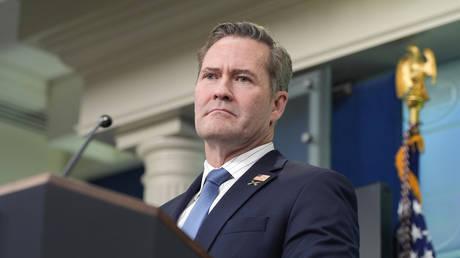 Vance asked Trump to fire Waltz – Politico
Vance asked Trump to fire Waltz – Politico
Politico identified Trump’s special envoy Steve Witkoff as a “leading pick” to replace Waltz. The official has been instrumental in Washington’s efforts to facilitate the peace process between Russia and Ukraine. He has visited Moscow several times lately, including for talks with Russian President Vladimir Putin.
CNN journalist Alayna Treene claimed, citing her sources close to Witkoff, that the special envoy was not interested in taking over as national security advisor and that his team does not expect him to ultimately be picked by Trump for the role.
Last month, the media outlet also reported that US Vice President J.D. Vance and other senior officials suggested that Trump fire Waltz over the ‘Signalgate’ scandal. Back then, the president reportedly agreed that Waltz had “messed up,” but decided not to dismiss him. Trump had previously downplayed the controversy as a “witch hunt” and questioned the reliability of Signal. He also maintained that no classified information was compromised because of the leak.
-
Site: LifeNews
New York’s state Assembly voted April 29 to legalize physician-assisted suicide, advancing a deeply controversial bill that opponents say undermines the sanctity of life and endangers the vulnerable.
The bill, known as the Medical Aid in Dying Act, passed 81-67 after hours of debate and years of failed attempts, the New York Post reported. The law would allow mentally competent adults with a terminal diagnosis of six months or less to request a prescription for life-ending drugs.
Several lawmakers voiced strong moral objections during the floor debate.
“Each and every life has value,” Assemblywoman Mary Beth Walsh, R-Saratoga, said. “Progress may not be on a straight line and will look different to each of us, but this idea of giving up and dying is not excelsior, ever upward. It’s incredibly sad.”
Walsh was joined by about 20 Democrats who broke ranks to vote against the bill, including Assembly Majority Leader Crystal Peoples-Stokes, D-Erie.
“I watched my mom die. I watched my daughter die,” Peoples-Stokes said. “At some point or the other, we’re all going to go, but I don’t believe there should be a combination of six drugs offered to someone to end their life.”
Assemblywoman Amy Paulin, D-Westchester, the bill’s sponsor, said her sister’s death from ovarian cancer inspired her to push for the legislation.
While the measure now heads to the Senate, its future remains uncertain. Senate Majority Leader Andrea Stewart-Cousins, D-Westchester, said she’s open to discussion but made no commitment to a vote. Gov. Kathy Hochul has also stayed silent on whether she would sign the bill if it reaches her desk.
Religious leaders and disability rights advocates remain staunchly opposed.
“New York State should instead strengthen palliative care, improve health care services and counseling for people in crisis and show America what real compassion looks like,” said Robert Bellafiore, spokesperson for the New York State Catholic Conference, according to the New York Post.
In a broader warning against the bill, the conference pointed to the evolving situation in Canada as a cautionary example. Since Canada legalized assisted suicide in 2015 for those with terminal and painful illnesses, the criteria have widened to include individuals with non-terminal but “intolerable” conditions.
Canadian policymakers have also proposed expanding eligibility to those with mental illness and even “mature minors,” according to the conference.
“These shocking developments prove that such a law, even with so-called safeguards, devalues human life,” the conference stated. “Implementing assisted suicide as an accepted medical ‘treatment’ sends the message that our most vulnerable populations are not worth the resources it might take to improve their lives. Those most at risk of being taken advantage of and discarded by the health system will be endangered further.”
LifeNews Note: Rachel Quackenbush writes for CatholicVote, where this column originally appeared.

The post Pro-Life Groups Fight to Stop New York Bill to Legalize Assisted Suicide appeared first on LifeNews.com.
-
Site: Zero HedgeMedicaid, SALT, & SNAP Debates Threaten Trump Agenda As Reconciliation Deadline LoomsTyler Durden Thu, 05/01/2025 - 11:25
As House Republicans race to pass President Trump’s sweeping domestic policy package, serious internal divisions remain unresolved, casting doubt over whether the party can meet its own ambitious deadlines.
Speaker Mike Johnson has set a tight three-week window to pass a massive reconciliation bill intended to enact the core of Trump’s economic agenda. Yet as of May 1, lawmakers remain deadlocked on several of the package’s most contentious provisions, from tax policy to cuts in federal safety-net programs.
“We’re working through each of the final issues,” House Majority Leader Steve Scalise told Punchbowl News, acknowledging that the package is “coming down the wire” even as four committees have already advanced their legislative proposals. Behind the scenes, however, critical components of the legislation remain in flux.
Major Tax Questions Still Unanswered
Nowhere is the uncertainty more apparent than in the House Ways and Means Committee, where the $4.5 trillion tax section of the package remains in limbo. A formal markup has not been scheduled, though May 8 is being discussed as a target date, Punchbowl reports.
One of the most intractable issues is the state and local tax (SALT) deduction cap. Several Republican lawmakers from high-tax states, especially New York, are pressing for the $10,000 cap to be lifted or substantially increased. Speaker Johnson met Wednesday with members of the SALT Caucus to gather “final feedback” before a new cap is finalized.
But lawmakers involved in the talks described them as far from conclusive. “We’re still far away from being done,” said Representative Nick LaLota, Republican of New York. Proposals to raise the cap to $25,000 have failed to unify the group, and disagreements persist over how to address the so-called marriage penalty, which currently imposes the same cap on joint filers as on single taxpayers.
For GOP reps like LaLota and Mike Lawler, also of New York, resolving the SALT issue is politically non-negotiable.
Medicaid Cuts Draw Moderate Resistance
Similar discord surrounds proposed Medicaid changes. Republicans on the House Energy and Commerce Committee continue to deliberate over how to achieve $880 billion in savings, a task that has sparked pushback from centrist members concerned about the scale of potential cuts.
Representative Juan Ciscomani of Arizona said talks were “making progress” following a meeting with Committee Chair Brett Guthrie. Still, disagreements remain, particularly over proposals to impose per capita caps on Medicaid spending - a sticking point for members like Representative Don Bacon of Nebraska, who supports no more than $500 billion in total reductions.
“For them to do any more,” Mr. Bacon said, “they’re going to have to prove it doesn’t hurt people’s health care or hospitals.”
Energy and Commerce is scheduled to hold a markup on May 7, with Republicans on the panel meeting again Thursday morning to try to bridge remaining divides.
Food Stamp Reform in Flux
The Supplemental Nutrition Assistance Program (SNAP) has also emerged as a flashpoint. The House Agriculture Committee is under pressure to find $230 billion in savings but has yet to finalize a plan.
Chair Glenn Thompson of Pennsylvania is opposed to cutting benefits and instead favors a cost-sharing model that would shift more of the financial burden to states. However, that idea has drawn criticism from both the White House and within the Republican conference.
Mr. Bacon has suggested a simpler solution: scale back the required savings. “They need to lower the $230 [billion] to $100 [billion],” he said.
Mr. Thompson has signaled that he does not want to see changes to the Thrifty Food Plan, a government benchmark for SNAP benefit levels. But the path forward remains unclear as Republicans weigh political risks and the Trump administration awaits feedback on key proposals.
Clock's ticking guys...
Trump administration officials have indicated they want Congress to complete the reconciliation process by July 4. Yet with major pieces of the package still unresolved, that deadline appears increasingly difficult to meet.
The current impasse reflects a broader challenge facing House Republicans: how to reconcile ideological differences within their own ranks while moving forward on a sprawling policy package. Each committee’s internal debate has created ripple effects, complicating the broader legislative effort.
The coming weeks will test whether the Republican leadership can align its members around the former president’s agenda - or whether the reconciliation effort will stall under the weight of unresolved conflicts.
-
Site: LifeNews
Texas Senators passed the Woman and Child Protection Act, which would crack down on abortion pills sent in the mail or brought in from other states and countries. On the same day, the Life of the Mother Act and Conscience Protections for Health Care Professionals also passed the Texas Senate.
These are big wins, with half of the legislative process now complete for the Pro-Life measures! Lawmakers now have less than a month to move Pro-Life policies across the finish line.
The Woman and Child Protection Act (SB 2880 & HB 5510) seeks to combat the growing threat of abortion pills being sent to Texas from other states and countries. If passed, Texas will become the first to attack the abortion industry’s underground network—setting a powerful example for the rest of the nation to follow. Thankfully, the act has already been heard in a House committee. This measure must now be quickly voted to the next step before being debated by all the representatives and then signed into law by the governor.
The Woman and Child Protection Act is one of two Pro-Life Priority Bills. The second, the Stop Tax-Funded Abortion Travel Act, already passed the Senate and is waiting to be heard in a committee in the Texas House of Representatives.
Click Like if you are pro-life to like the LifeNews Facebook page!
(function(d, s, id) { var js, fjs = d.getElementsByTagName(s)[0]; if (d.getElementById(id)) return; js = d.createElement(s); js.id = id; js.src = "//connect.facebook.net/en_US/sdk.js#xfbml=1&version=v2.10"; fjs.parentNode.insertBefore(js, fjs); }(document, 'script', 'facebook-jssdk'));
The Senate also advanced two recommended bills, the Life of the Mother Act (SB 31 & HB 44) and the Conscience Protections for Healthcare Professionals Act (SB 619 & HB 2816).
The Life of the Mother Act will offer free training to doctors and hospital attorneys on how to treat pregnant women in emergencies and follow Pro-Life laws. The measure would ensure health care professionals have confidence when addressing life-threatening pregnancy complications but would not add loopholes that would harm preborn babies. Pro-Life laws in Texas already allow doctors to intervene if the mother’s life is at risk, but false media reports have led hospital staff to believe otherwise. This bill seeks to resolve this, highlighting once again that Pro-Life protections and emergency care work in harmony.
Lastly, Senate Bill 619 would protect health care workers from being punished for refusing to take part in procedures that violate their beliefs. It expands current protections while still requiring emergency and life-saving care.
Each bill must now move through the House committee process. The Woman and Child Protection Act only needs to be voted out of the committee, since it has already had a hearing. However, the other bills still need to be heard in a committee meeting before they can move on to the next step. If passed from committee, each bill must then be scheduled by the Calendars Committee and voted upon by all the representatives before May 27.
This legislative session could be one of the most impactful yet for the Pro-Life movement in Texas—but the fight isn’t over! These bills now face their final steps in the House, and we need every voice to speak up.
Your prayers, advocacy, and support can help turn these tentative victories into lasting laws that protect mothers, save babies, and hold the abortion industry accountable. Together, we can make history and ensure Texas continues to lead the nation in defending Life.
Click here to contact your lawmakers to support the bill.

The post Texas Senate Passes Bill Stopping Abortion Pills appeared first on LifeNews.com.
-
Site: RT - News
The flag is a giant replica of the one hoisted by Soviet soldiers over the Reichstag in Berlin 80 years ago
The Venezuelan authorities have raised a giant replica of the Banner of Victory in the capital, Caracas to commemorate the defeat of Nazi Germany by the Soviet Union. Red Army troops hoisted the flag of the USSR atop the Reichstag building in Berlin on May 1, 1945.
The banner, measuring 25 by 11 meters – the largest ever displayed outside Russia – was hoisted in the Venezuelan capital on April 30. Venezuelan President Nicolas Maduro declared the date the ‘Day of the Victory of Mankind over Fascism’.
On April 30, 1945, Red Army soldiers broke into the Reichstag through breaches in the walls and captured the building. The legendary Red Banner No. 5, which later became the famed Victory Banner, was raised on top of the Reichstag dome by soldiers from the 756th Rifle Regiment – Sergeant Mikhail Egorov and Junior Sergeant Meliton Kantariya.
“In 1945, on a day like today, the world heard on the radio and learned from telegraphic messages – there were no social networks then, no satellites – that the Red Army of the Soviet Union had entered Berlin, defeated Hitler, and planted the banner of the Soviet Union over the Reichstag,” Maduro said.
The USSR lost an estimated 26.6 million lives during World War II. Moscow will celebrate the anniversary of victory over Nazi Germany and hold its annual Victory Day parade on Red Square on May 9.
In April, Russian Foreign Minister Sergey Lavrov said Moscow expects the Venezuelan leader to visit Russia on May 9 to take part in the 80th anniversary celebrations.
 1941-1945 Great Patriotic War. The Banner of Victory on the Reichstag building in Berlin, May 1, 1945.
© Sputnik / Vladimir Grebnev
1941-1945 Great Patriotic War. The Banner of Victory on the Reichstag building in Berlin, May 1, 1945.
© Sputnik / Vladimir Grebnev
“The raising of the largest Victory Banner outside Russia here in Caracas symbolizes the deep bond between our peoples, our shared commitment to truth, freedom, and peace,” Russian Ambassador to Venezuela Sergey Melik-Bagdasarov said during the flag-raising ceremony.
-
Site: The Remnant Newspaper - Remnant ArticlesEminences, you know that this situation in which the hierarchy of the Church persecutes Traditional Catholics would be comical were it not so tragic. Please elect a shepherd for all Catholics, including those who humbly wish to follow the only Gospel that St. Paul would recognize as Christian.
-
Site: Henrymakow.com
 Please send links and comments to hmakow@gmail.comWhy Did Trump Snub Canada's Trump?Was this Canada's last election as a united nation?Canada is Fractured on a West-East BasisPierre Poilevre was considered "Canada's Trump"Many Conservatives supported TrumpPoilievre and his supporters were Zionists like Trump.Yet Trump endorsed Carnage?Trump says Poilievre said "negative things about him" so he prefers CarneyCarnage is the polar opposite of Trump, a Communist in the Communist-Zionist Illuminati charade.He is opposed to Trump's Gaza genocide.Poilievre should have made a deal with Trump (i.e. kissed his ass) the moment he saw the polls were leaningtoward the Liberals. He was still campaigning on "axe the carbon tax" when he should have been presenting himself as the man who made a deal with Trump.Was this an honest error? Or was it deliberate?Trump's betrayal of a Canadian nationalist reminds me of how the Nazis destroyed their nationalist allies in Romania.They would not foster any other nationalism but their own.Trump's plot may be for Western Canada to join the US! There are many calls for separation which inevitably would mean union with the US.Poilievre, Carney and Danielle Smith may be in on it. They're all Freemasons like Trump.--
Please send links and comments to hmakow@gmail.comWhy Did Trump Snub Canada's Trump?Was this Canada's last election as a united nation?Canada is Fractured on a West-East BasisPierre Poilevre was considered "Canada's Trump"Many Conservatives supported TrumpPoilievre and his supporters were Zionists like Trump.Yet Trump endorsed Carnage?Trump says Poilievre said "negative things about him" so he prefers CarneyCarnage is the polar opposite of Trump, a Communist in the Communist-Zionist Illuminati charade.He is opposed to Trump's Gaza genocide.Poilievre should have made a deal with Trump (i.e. kissed his ass) the moment he saw the polls were leaningtoward the Liberals. He was still campaigning on "axe the carbon tax" when he should have been presenting himself as the man who made a deal with Trump.Was this an honest error? Or was it deliberate?Trump's betrayal of a Canadian nationalist reminds me of how the Nazis destroyed their nationalist allies in Romania.They would not foster any other nationalism but their own.Trump's plot may be for Western Canada to join the US! There are many calls for separation which inevitably would mean union with the US.Poilievre, Carney and Danielle Smith may be in on it. They're all Freemasons like Trump.-- Trump says Poilievre "said negative things about him" so he prefers CarneyAlberta's Exit Plan: Will It Become the 51st State?Was Canada's break up part of Trump's strategy?Read the comments. Western Canadians are finshed with CanadaAlberta wants OUT? Constitutional lawyer explains REFERENDUM changes and path to independenceThe four Maritime provinces have a third of Alberta's population but more seats in Parliament----ICE in First 100 Days: Almost 70K Illegals Arrested, Nearly 66K Removed; 75 Percent Dangerous CriminalsU.S. Immigration and Customs Enforcement collared almost 70,000 illegal aliens during the first 100 days of the Trump administration, and removed almost 66,000, the vast majority of whom were criminals.As well, the agency reported today, thousands of the deportees were terrorists linked to the gangs that President Donald Trump labeled terrorist organizations on Day 1 of his presidency. Data from U.S. Customs and Border Protection show a 90-percent drop of encounters at the southwest border.-
Trump says Poilievre "said negative things about him" so he prefers CarneyAlberta's Exit Plan: Will It Become the 51st State?Was Canada's break up part of Trump's strategy?Read the comments. Western Canadians are finshed with CanadaAlberta wants OUT? Constitutional lawyer explains REFERENDUM changes and path to independenceThe four Maritime provinces have a third of Alberta's population but more seats in Parliament----ICE in First 100 Days: Almost 70K Illegals Arrested, Nearly 66K Removed; 75 Percent Dangerous CriminalsU.S. Immigration and Customs Enforcement collared almost 70,000 illegal aliens during the first 100 days of the Trump administration, and removed almost 66,000, the vast majority of whom were criminals.As well, the agency reported today, thousands of the deportees were terrorists linked to the gangs that President Donald Trump labeled terrorist organizations on Day 1 of his presidency. Data from U.S. Customs and Border Protection show a 90-percent drop of encounters at the southwest border.- The Masonic handshake between Fidelito and Danielle Smith is now available on video.Senate Republicans added an amendment to bipartisan legislation addressing rising antisemitism on college campuses that could be seen as a concession to Christian conservatives who want to protect those who preach that the Jews killed Jesus.Senate committee approves amendment to Antisemitism Awareness Act stating criticism of Israeli government isn't antisemiticSen. Bernie Sanders proposed the amendment as well as two others-Chabad Errand Boy Putin condemns antisemitism in RussiaViewer--"I'm pretty sure Putin knows who caused the massacre of 40+ million Christians in Russia before WW2...So hearing this out of him makes me lose faith in him quite a bit..."-FBI agents seen kneeling in infamous George Floyd protest picture demotedBut the change comes amid a broader effort by President Donald Trump's new FBI Director Kash Patel to root out what the president has called 'woke' and politicized elements within the bureau.Some who worked on criminal cases against Trump and led field offices across the country have reportedly also been removed from their positions, often without any reason, according to the Washington Post.-
The Masonic handshake between Fidelito and Danielle Smith is now available on video.Senate Republicans added an amendment to bipartisan legislation addressing rising antisemitism on college campuses that could be seen as a concession to Christian conservatives who want to protect those who preach that the Jews killed Jesus.Senate committee approves amendment to Antisemitism Awareness Act stating criticism of Israeli government isn't antisemiticSen. Bernie Sanders proposed the amendment as well as two others-Chabad Errand Boy Putin condemns antisemitism in RussiaViewer--"I'm pretty sure Putin knows who caused the massacre of 40+ million Christians in Russia before WW2...So hearing this out of him makes me lose faith in him quite a bit..."-FBI agents seen kneeling in infamous George Floyd protest picture demotedBut the change comes amid a broader effort by President Donald Trump's new FBI Director Kash Patel to root out what the president has called 'woke' and politicized elements within the bureau.Some who worked on criminal cases against Trump and led field offices across the country have reportedly also been removed from their positions, often without any reason, according to the Washington Post.-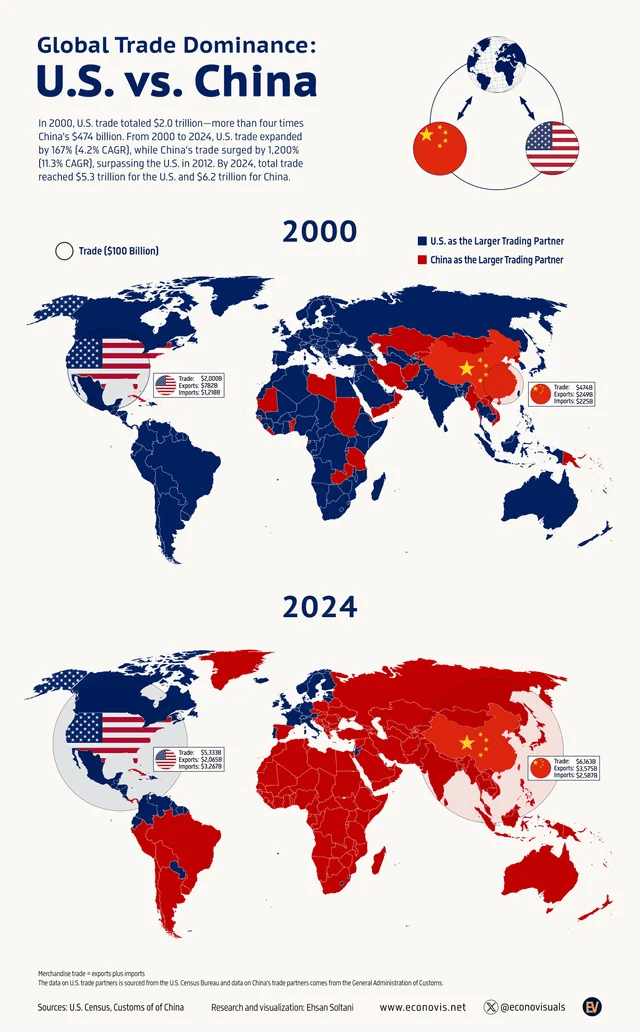 Graph showing the growth of Chinese world trade vs US world trade-From 2000 to 2024, US trade expanded 167% compared to China's 1200% growth.By 2024 total trade reached $5.3 T for the US and $6.2 T for China.---Canada the IllusionCanada never was a sovereign independent nation.-Alex Soros fumes at left-wing climate group over 'Palestine' obsession: 'What the hell...All they do is talk about Palestine'In an interview with New York Magazine in which he detailed his plans to fund efforts to foil the Trump administration's agenda, Soros expressed his frustration with the leftist environmentalist group "Sunrise Movement," which is heavily funded by Soros-backed organizations."What the hell did they do, by the way?" Soros, who is Jewish, complained. "We gave them money, and now all they do is talk about Palestine. It's ridiculous."-Makow -- Commie Soros defends Palestine genocide. They are joined at the top.
Graph showing the growth of Chinese world trade vs US world trade-From 2000 to 2024, US trade expanded 167% compared to China's 1200% growth.By 2024 total trade reached $5.3 T for the US and $6.2 T for China.---Canada the IllusionCanada never was a sovereign independent nation.-Alex Soros fumes at left-wing climate group over 'Palestine' obsession: 'What the hell...All they do is talk about Palestine'In an interview with New York Magazine in which he detailed his plans to fund efforts to foil the Trump administration's agenda, Soros expressed his frustration with the leftist environmentalist group "Sunrise Movement," which is heavily funded by Soros-backed organizations."What the hell did they do, by the way?" Soros, who is Jewish, complained. "We gave them money, and now all they do is talk about Palestine. It's ridiculous."-Makow -- Commie Soros defends Palestine genocide. They are joined at the top. -
Site: RT - News
Washington reportedly refused to include any formal commitments early in the negotiation process
The US has rejected Ukraine’s request for security guarantees as part of a newly signed mineral resources agreement, the New York Times reported on Wednesday, citing sources familiar with the talks.
The nine-page deal, signed the same day after months of negotiations and published on Thursday by the Ukrainian government, gives Washington preferential access to Ukraine’s mineral projects, including rare-earth metals. It also establishes a joint investment fund to support Ukraine’s post-conflict reconstruction.
Despite its scope, the final agreement contains no formal pledge of future US military support, a key demand from Ukraine during negotiations. Instead, it vaguely mentions a “long-term strategic alignment” and promises US backing for Ukraine’s “security, prosperity, reconstruction, and integration into global economic frameworks.” One source told the NYT that the US dismissed the idea of providing Kiev with explicit security guarantees early in the talks.
State Department spokeswoman Tammy Bruce defended the agreement, suggesting that US involvement alone offers implicit protection.
Read more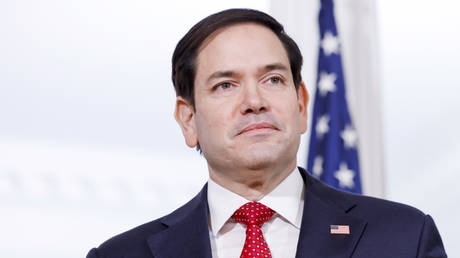 US-Ukraine deal ‘important step to end war’ – Rubio
US-Ukraine deal ‘important step to end war’ – Rubio
“When America is your friend and your partner, your nation is going to be better off. And there is a security component just in our presence,” she told Fox Business.
Analysts told the NYT that the deal could help secure US President Donald Trump’s continued interest in Ukraine now that he is directly invested, and will potentially open the door to further discussions on military aid and a ceasefire with Russia. Still, critics argued that without binding guarantees, the deal’s impact may be limited if the conflict continues.
READ MORE: US-Ukraine deal ‘important step to end war’ – Rubio
Ukraine’s parliament is expected to ratify the agreement within two weeks. The US has framed the deal as a way for Ukraine to repay past military aid – estimated at $350 billion by Trump, though Kiev claims the figure is closer to $100 billion and that the support was unconditional. The debt repayment clause, however, was dropped from the final text. After signing, Trump said the US could “in theory” recover “much more” than $350 billion through the deal.
Commenting on the deal, deputy head of the Russian Security Council Dmitry Medvedev said the US has essentially “forced the Kiev regime to pay for American aid with minerals,” warning that all future military supplies will have to be paid “with the national wealth of a vanishing country.”
-
Site: Zero HedgeThe Baby Hoax: Reporters Repeat False Narrative Over Child DeportationsTyler Durden Thu, 05/01/2025 - 10:25
For years, the mainstream media has been criticized for open political bias, including repeating false narratives and claims.
There is little evidence that that will change despite falling revenues and audiences.
That was evident this week as leading journalists continued to raise a dubious claim about the Trump Administration deporting children, including cancer patients.
The media has been promulgating a false claim that children as young as four are being deported.
The Administration immediately stated that the decision rested with the mothers on whether they would take the children or leave them in the United States with family.
Many of the same figures accused of promulgating false stories quickly picked up the spin from the Washington Post.
On NBC’s Meet the Press, Kristen Welker pursued the narrative with Secretary of State Marco Rubio:
KRISTEN WELKER: Let’s talk now about some new reporting that came in overnight. I want just to go through it with you and for our audience. Three U.S. citizen children have been deported with their mothers. Now this is according to The Washington Post. The family’s lawyer says one of them is a 4-year-old with Stage 4 cancer, deported without medication or ability to contact doctors. The family’s lawyers are also saying their clients were denied communication with family and legal representatives before being deported, and it’s raising concerns about the issue of due process. That it’s being violated. So let me ask you, is everyone on U.S. soil, citizens and non-citizens, entitled to due process?
MARCO RUBIO: Yes, of course. But let me tell you, it looks- in immigration standing, the laws are very specific. If you are in the country unlawfully, you have no right to be here and you must be removed. That’s what the law says. Somehow over the last 20 years, we’ve completely lost this notion that somehow- or completely adopted this idea that yes, we have immigration laws but once you come into our country illegally it triggers all kinds of rights that can keep you here indefinitely. That’s why we were being flooded at the border, and we’ve ended that. And that’s why you don’t- you see a historically low number of people not just trying to cross our border, trying to cross the border into Panama, all the way down in the Darien Gap. I mean- i it’s been a huge help for those countries as well. On the headline- that’s a misleading headline. Okay? Three U.S. Citizens, ages 4, 7 and 2 were not deported. Their mothers who were illegally in this country were deported. The children went with their mothers. Those children are U.S. citizens- they can come back into the United States- there’s- their father or someone here who wants to assume them. But ultimately who was deported was the mother- their mothers who were here illegally. The children just went with their mothers. But it wasn’t like- you guys make it sound like ICA agents kicked down the door and grabbed the 2 year-old and threw them on an airplane. That’s misleading. That’s just not true.
That would ordinarily leave a journalist looking at their shoes in embarrassment, but Welker decided to double down and add the claim that children are being denied “due process”:
WELKER: Just to be clear, because I do want to get to the overhaul at the State Department. Is it the U.S. policy to deport children, even U.S. citizens, with their families- and I hear what you’re saying- without due process? Just to be very clear there.
RUBIO: Well- no, no, no. No, no. Again, if someone is in this country unlawfully, illegally, that person gets deported. If that person is with a 2-year-old child or has a 2-year-old child and says “I want to take my child with you- with me,” well then you have two choices. You can say yes, of course, you can take your child whether they’re a citizen or not because it’s your child or you can say yes, you can go, but your child must stay behind. And then your headlines would read, “U.S. holding hostage 2-year old, 4-year-old, 7-year-old, while mother deported.”
There is a great deal of litigation working through the courts on the level of due process required for deportations. The public overwhelmingly supports the deportation of unlawful immigrants and elected Trump based on his pledge to carry out such deportations. Unlawful immigrants often spend years in this country despite orders of deportation or removal. The level of review depends on their status. If they have previously entered unlawfully, they are subject to expedited removal.
The critical point, however, is that the children are not being deported.
If they were born in this country, they are still treated as U.S. citizens (though the Administration is challenging birthright citizenship in the courts).
Having a child in the United States does not make parents immune from removal or afford them special legal status over other deportees.
Over at CBS, Margaret Brennan (who was criticized for her “fact checks” in the presidential debate) also jumped on the narrative in interviewing Border Czar Tom Homan on Face the Nation:
MARGARET BRENNAN: On Friday, there were three American citizen children, born here, who were deported along with their mothers from Louisiana down to Honduras. And according to advocates, one of them is a 4-year-old child with Stage Four cancer. A rare form of metastatic cancer who was sent back to Honduras without getting to talk to a doctor and without medication. I understand this child’s mother entered this country illegally. But isn’t there some basis for compassionate consideration here that should have allowed for more consultation or treatment?
TOM HOMAN: Well, it certainly is discretionary. I’m not aware of this specific case. But no U.S. citizen child was deported. Deported means you gotta be ordered — reported by the immigration judge. We don’t deport U.S. citizens.
BRENNAN: The mother was deported along with the children.
HOMAN: These children- Children aren’t deported. The mother chose to take the children with her. When you enter the country illegally and you know you are here illegally and you choose to have a U.S. citizen child, that’s on you. That’s not on this administration. If you choose to put your family in that position, that’s on them. But having a U.S. citizen child, after you enter this country illegally, is not a “get out of jail free” card. It doesn’t make you immune from our laws. If that’s the message we send to the entire world, women are going to keep putting themselves at risk and come to this country. We send a message: you can enter the country illegally, that’s okay, you can have due process at great taxpayer expense, get ordered to move, that’s OK. Don’t leave, but have a U.S. citizen child and you are immune from removal? That’s not the way it works.
BRENNAN: So you don’t think there should be compassionate consideration for a 4-year-old child undergoing treatment for cancer?
HOMAN: I didn’t say that. I said ICE officers do have discretion-
BRENNAN: That was the question.
HOMAN: ICE officers do have discretion. I’m not familiar with the specific case. I don’t know what facts surround this case. I was just made aware of this when you mentioned it this morning. I was not aware of that case.
Brennan correctly noted that a court recently found a lack of due process in a child’s case. However, Holman had a reasonable response in citing the mother’s election in this one case to leave with her child.
BRENNAN: On Friday, a federal judge who was appointed by President Trump said a 2-year-old American citizen child had been sent to Honduras with the mother. But the judge said, quote: “there was no meaningful process.” So again, this is another similar situation and dynamic. Shouldn’t there be special care when the deportation cases involve small American-born children?
HOMAN: First of all, I disagree with the judge. There was due process. That female had due process at great taxpayer expense and was ordered by an immigration judge after those hearings. So she had due process. Again, this is Parenting 101. And you can decide to take that child with you or you can decide to leave the child here with a relative or another spouse. Having a child doesn’t make you immune from our laws of the country. American families get separated every day by law enforcement- thousands of times a day. When a parent gets put in jail, the child can’t go with them. If you are an illegal alien and you come to this country and you decide to have a U.S. citizen child, that’s on you. You put yourself in that position.
BRENNAN: Well, when it came to this particular case, you just pointed out that they could have made arrangements. The father tried, actually, to make arrangements as we understand it through our reporting. But he and the mother who were separated, since she was in detention after showing up for her appointment, was only allowed a very brief phone call. The father tried to petition to get the child handed over to an American citizen relative. So the mother had to make this decision and took the child with her. It just seems like there could be some more time frame here around due process allowed. That’s what the judge is saying, is saying- there should have been more of a process here.
HOMAN: There was due process. The 2-year-old baby- the two year old baby was left with the mother because the mother signed a document requesting her 2-year-old baby go with her. That’s the parent’s decision. I don’t think the judge knows the specifics of this case. The 2-year-old went with the mom. The mom signed a paper saying, “I want my 2-year-old to go with me.” That’s a parent’s decision. It’s not a government decision, it’s a parent’s decision.
BRENNAN: The father wrote a note. Anyhow, we have to leave it there, Director. Thank you for your time today. We’ll be right back.
It is important to note that these are two very different cases that were blended into the coverage.
In the second case, the government insists that there was no prior arrangement for the child to be left with the family and that the mother made this decision.
ICE should endeavor to accommodate such requests and there should always be an inquiry into allegations that these women were prevented from making arrangements for their children to remain in the country. However, there will also be practical limits in addressing those issues in the midst of a removal.
If Homan is correct, the mother was in the system long before the actual removal. The father “sending a note” at the end of that process is worth looking into, but it is hardly surprising that the removal proceeded with the mother’s consent.
The same narrative was playing over at ABC as Martha Raddatz had this exchange with former DoJ spokesperson Sarah Isgur:
MARTHA RADDATZ: Sarah, I want to turn here to some information that has been in The Washington Post about deportations of very young children who are American citizens. A 2-year-old, a 4-year-old, a 7-year-old sent back to Honduras. Is that legal?
SARAH ISGUR: This is something our immigration system deals with nearly every day. U.S. citizen children have to make that decision with their parents of whether they’re going to stay. The parent has the decision. We do not allow illegal alien parents to stay just because they have custody over U.S. citizen children, and at least one of these cases with the 2-year-old, the mother was the one who made the decision to take her daughter with her. The father is the one saying he wanted the daughter to stay here. Often times, it’s going to look more like a custody dispute than an immigration question.
Again, as Isgur correctly points out, this is the election of the parents who are being removed.
Critics have pushed back on these interviews, noting how the media seemed only marginally interested in thousands of children lost in the system under the Biden Administration as millions poured over the border.
The coverage suggested that children were being thrown on planes to be dumped in some foreign land.
The Washington Post, which is cited for the story, has been repeatedly accused of pushing misleading or false narratives. There was a recent riot in the newsroom when owner Jeff Bezos demanded that the newspaper return to more balanced coverage.
The most telling condemnation came from Post columnist Philip Bump, who wrote “what the actual f**k.” Bump has been repeatedly accused of false claims and previously had a meltdown in an interview when confronted about past false claims. After I wrote a column about the litany of such false claims, the Post surprised many of us by stating that it stood by all of Bump’s reporting, including false columns on the Lafayette Park protests, Hunter Biden’s laptop, and other stories. That was long after other media debunked the claims, but the Post stood by the false reporting.
We have previously discussed the sharp change in culture at the Post, which became an outlet that pushed anti-free speech views and embraced advocacy journalism. The result was that many moderates and conservatives stopped reading the newspaper.
In my book on free speech, I discuss at length how the Post and the mainstream media have joined an alliance with the government and corporations in favor of censorship and blacklisting. I once regularly wrote for the Post and personally witnessed the sharp change in editorial priorities as editors delayed or killed columns with conservative or moderate viewpoints.
Last year, that culture was vividly on display when the newspaper offered no objection or even qualification after its reporter, Cleve Wootson Jr., appeared to call upon the White House to censor the interview of Elon Musk with former President Donald Trump. Under the guise of a question, Wootson told White House Press Secretary Karine Jean-Pierre “I think that misinformation on Twitter is not just a campaign issue…it’s an America issue.”
The baby hoax shows that little has (or likely will) changed. In the meantime, the public is moving on. New media is rising as mainstream media audiences shrink. Journalists and columnists are increasingly writing for each other as polling shows trust in the media is at an all-time low.
Robert Lewis, a British media executive who joined the Post, reportedly got into a “heated exchange” with a staffer. Lewis explained that, while reporters were protesting measures to expand readership, the very survival of the paper was now at stake:
“We are going to turn this thing around, but let’s not sugarcoat it. It needs turning around,” Lewis said. “We are losing large amounts of money. Your audience has halved in recent years. People are not reading your stuff. Right. I can’t sugarcoat it anymore.”
It simply does not matter. The media continues to vigorously saw on the branch upon which it is sitting.
Jonathan Turley is the Shapiro professor of public interest law at George Washington University and the author of “The Indispensable Right: Free Speech in an Age of Rage.”
-
Site: RT - News
Beijing has to carefully balance between its longtime partner and its regional rival if it wants to keep its interests safe
As tensions flare once again between India and Pakistan following a deadly attack in Kashmir last week, China is trying to balance between the two sides. It is being squeezed between strong commitments toward Islamabad and interest in developing economic cooperation and reviving relations with New Delhi.
In response to the bloodshed and the rapid escalation of tensions in the region, Beijing called on India and Pakistan to exercise restraint, resolve the conflict peacefully, and work jointly for regional peace and stability. Such rhetoric belongs to China’s usual diplomatic repertoire, reflecting an emphasis on predictability and stability, enabling Beijing to promote its economic interests and continue conducting business wherever possible. Quite often, rhetoric does not translate into concrete actions as Beijing remains committed to a non-alignment policy and does not want to be dragged into conflicts between third parties.
Vocalizing principles of peaceful coexistence, China hesitates to become an active security and military player at the international level. Indeed, an active role brings not only benefits but also considerable risks. China would run the risk of losing the image of a peaceful power with an aversion to hegemony, power politics, and traditional great power competition. At the same time, Chinese neutrality often brings positive implications for one of the conflicting sides. One can hardly overlook that Islamabad, rather than New Delhi, benefits more from China’s neutrality in the current situation.
Although China strongly condemned the attack in Pahalgam, it offered no assistance to India and did not accept New Delhi’s interpretation of the events. Instead of embracing the allegations linking Pakistan with the attack, Beijing supported the Pakistani government’s call for a swift and fair investigation. Talking to his Pakistani counterpart on April 27, Foreign Minister Wang Yi highlighted that China understood the legitimate security concerns of its ‘ironclad friends’ in Islamabad, supporting Pakistan in safeguarding sovereignty and security. Wang’s comments indicate that Beijing remains very serious about the commitments toward Islamabad and reserved in relation to India.
Read more India responds to ‘unprovoked firing’ by Pakistan – media
India responds to ‘unprovoked firing’ by Pakistan – media
This position has historical and geopolitical reasons. India and Pakistan have had serious disagreements since the partition of India in 1947. The two sides have been engaged in several rounds of military confrontation since then. Territorial claims are one of the sources of hostility. Kashmir has been divided between India, Pakistan and China, which provokes a certain frustration in each of the three capitals. No less importantly, Pakistan ceded some territories to China in 1963, which has not been recognized by India. While the agreement became at the time an important moment in deepening ties between Islamabad and Beijing, it only widened the gap between New Delhi and Beijing. Through this prism, China can hardly be accepted by the Indian side as an intermediary and neutral actor in the present conflict. Beijing’s involvement in the problem is too strong, whether China realizes it or not.
China’s position in the ‘triangle’ is complicated by the fact that Pakistan has gradually turned into Beijing’s closest strategic partner. The scope of bilateral cooperation is wide and goes far beyond what is typical of the relationship between China on the one hand and India and other regional players on the other hand. When Xi Jinping launched the Belt and Road Initiative (BRI) in 2013, the Sino-Pakistani economic corridor (CPEC) became one of the flagship projects of the Chinese global initiative. It enabled Beijing to get direct access to the Arabian Sea via Gwadar Port and strengthen its position in that strategic area. The Sino-Pakistani cooperation within the CPEC was perceived very negatively in India, even more so because some projects were implemented in the disputed territories in Kashmir. New Delhi is concerned by close defense and military relations between Islamabad and Beijing, as China has become the country’s largest arms supplier and the two sides agreed on joint training, military technology transfers, and intelligence sharing.
Geopolitical and geoeconomic motives drive China’s stake in Pakistan. The partnership with Islamabad helps Beijing to exert pressure on New Delhi and counterweight India’s growing regional ambitions. At the same time, a strong and stable India does not necessarily contradict China’s interests. Despite mistrust and disagreements, India is one of China’s top trading partners. India’s domestic market creates huge opportunities for Chinese exporters, and the presence of Chinese investors in the country has been strong for a long time. Paradoxically, the conflict between India and Pakistan comes at a moment when Sino-Indian relations have been warming. The two countries have recently agreed on de-escalating border tensions and resuming joint border patrols and direct flights. The conflict in Kashmir could reverse this trend.
Read more Modi gives army ‘freedom’ to respond to Kashmir carnage – media
Modi gives army ‘freedom’ to respond to Kashmir carnage – media
Although the Sino-Indian relations have fluctuated between cautious cooperation and military clashes, China might be receptive to India’s concerns in the ongoing conflict for several reasons. New Delhi is actively dealing with the threat posed by terrorism and Islamist groupings. Beijing also feels threatened by terrorism and Islamist-linked separatism in Xinjiang. Similarly, India’s bid for stabilization of and control over Kashmir is similar to Beijing’s approach to Xinjiang and other border regions. That is why both China and India are interested in countering actors who challenge the central authorities in Beijing and New Delhi, respectively. Moreover, China has already experienced direct attacks on its citizens in Pakistan, during which dozens of them were killed. Therefore, siding with the Pakistani government could challenge Beijing’s position as a staunch fighter against extremism and terrorism.
China has a vested interest in ensuring that the region does not become a hotbed of extremism or great power rivalry. Instability in Kashmir or Pakistan’s tribal regions poses a direct threat to China’s internal stability and its western frontier. A war between India and Pakistan would cause serious damage to China as it would endanger the CPEC, destabilize Xinjiang, and potentially draw in other global actors, undermining Beijing’s long-term regional ambitions.
At the same time, the current crisis creates an opportunity for Beijing and Washington to engage with each other constructively to help resolve the situation, as both India and Pakistan are traditionally important partners of the US. While China and the US have already adopted the same political stance, the chance to actively align on this matter and take active steps has not been used yet.
-
Site: Zero Hedge'Beneficial Switching Away From Imports' - US Manufacturing Surveys Signal No Recession In Q2Tyler Durden Thu, 05/01/2025 - 10:09
Following a slew of regional Fed surveys (and various other sentiment readings) sending 'soft' data dramatically lower (as 'hard' data continues to strengthen), this morning's Manufacturing PMIs are expected to signal further weakness.
Source: Bloomberg
The final S&P Global Manufacturing PMI did indeed disappoint, sliding from 50.7 flash print to 50.2 - exactly in line with March's final print (but below the 50.5 expected).
ISM's Manufacturing PMI beat expectations, printing 48.7 (down from the 49.0 in March but better than the 47.9 expectations) - lowest since Nov 2024.
So Hard data up, PMI flat, ISM down... take your pick
But none of the three factors point to a recession:
“The past relationship between the Manufacturing PMI® and the overall economy indicates that the April reading (48.7 percent) corresponds to a change of +1.8 percent in real gross domestic product (GDP) on an annualized basis,” says ISM's Timothy Fiore.
Under the hood, all the main components beat expectations with New Orders and Employment improving and Prices Paid rising (but less than expected)...
Admittedly, respondents are fearful of the impact of tariffs to come:
-
“Uncertainty over tariffs is providing a big challenge from both Tier-1 suppliers we will have to pay tariffs on directly and Tier-2 suppliers that will try to pass tariffs through to us in the form of price increases and tariff surcharges.” [Chemical Products]
-
“Tariffs impacting operations — specifically, delayed border crossings and duties calculations that are complex and not completely understood. As a result, we are potentially overpaying duties. Unsure of potential drawbacks. Implementation of tariffs and their application is sudden and abrupt. The business is taking countermeasures.” [Transportation Equipment]
-
“Business climate is apprehensive, and with tariff costs implemented, all inbound Chinese shipments are on hold. It is not feasible for our business or customers to sustain the pricing required to provide an acceptable margin.” [Computer & Electronic Products]
-
“The most important topic is tariffs. Risks include margin erosion due to rising operational costs and freight delays disrupting delivery timelines. Supplier relationships are strained by pain-share negotiations, and competitors are gaining share by importing from lower-tariff regions.” [Food, Beverage & Tobacco Products]
-
“Tariff whiplash is causing us major issues with customers. The two issues we are seeing: (1) customers are holding back orders to understand what is happening with tariffs on their products or (2) they are forcing us to accept the tariffs, which causes us to ‘no quote’ the job as we cannot take on that type of risk for an order.” [Machinery]
-
“There is a lot of concern about the inflationary impacts from tariffs in our industry. Domestic producers are charging more for everything because they can.” [Fabricated Metal Products]
-
“Tariff trade wars are incredibly volatile, quickly changing, and disrupting a ton of our current work. We are 90 percent sourced out of China, and the cost models keep changing every week. We are flying to visit suppliers in a few weeks to negotiate current terms and pricing, as well as develop more long-term, strategic plans to reduce risk in the region.” [Apparel, Leather & Allied Products]
-
“Demand is slightly lower than plan, but it has been steady amid tariff concerns. Significant time has been spent quantifying the impact of changing tariff rates. Our costs will increase, and we are discussing how to share that impact across suppliers and customers.” [Electrical Equipment, Appliances & Components]
-
“The recently imposed 145-percent tariff rate on Chinese imports is significantly affecting our 2025 profitability. Due to the complexity of our parts and the lack of alternate sources, we are unable to find any alternate suppliers — especially at a reasonable cost — to our current Chinese sources. Incoming orders have slowed due to market volatility and uncertainty.” [Miscellaneous Manufacturing]
"Manufacturing continued to flat-line in April amid worrying downside risks to the outlook and sharply rising costs," said Chris Williamson, Chief Business Economist at S&P Global Market Intelligence.
"Factory output fell for a second successive month as tariffs were widely blamed on a slump in export orders and curbed spending among customers more broadly amid rising uncertainty.
But, even they were forced to admit a small silver lining in the report...
"Although the survey saw some producers report evidence of beneficial tariff-related switching of customer demand away from imports, any such sales increase was countered by worries over tariff-related disruptions to supply chains and lost export sales.
This served to drive business confidence about prospects in the year ahead down sharply to the gloomiest for 10 months.
And just like all the other surveys, PMI respondents sees Prices rising...
"Concerns have also spiked in terms of input costs, especially for imported materials and components, due to the triple whammy of tariff-related price hikes, supply shortages, and the weaker dollar.
"Manufacturers are responding to these changing demand, supply and cost conditions by raising their selling prices and trimming headcounts to help protect their margins."
So, take what you will from this - are these data points a reflection of reality or the incessant FUD being peddled by the mainstream media?
If you need a reminder, as we noted earlier, there is a massive gap between what CEOs are saying and what CEOs are doing...
Corporate CEOs are just like Long Onlies on Wall Street: everyone is "apocalyptic", nobody is selling....
— zerohedge (@zerohedge) May 1, 2025
only here everyone is "apocalyptic", and nobody is firing pic.twitter.com/Wtu0uNeRqtWill CEOs suddenly announce massive waves of layoffs, or, with stocks now having erased all of the post-Liberation Day losses, will CEOs suddenly find a renewed optimism?
-
-
Site: southern orders
THIS IS COPIED FROM A GOOGLE SEARCH AND ITS ARTIFICIAL INTELLENGENCE SUMMARY OF CARDINAL PELL’S LETTER OF 2022:AI Overview
Cardinal George Pell wrote a secret memo, released under the pseudonym "Demos," that heavily criticized Pope Francis's pontificate. The memo, published in 2022, labeled Francis's papacy a "catastrophe" and accused him of various failings, including inaction on issues like the Chinese Communist Party's influence and the German Church's questioning of traditional doctrines. The memo also called for a new pope to restore doctrinal clarity, respect for the law, and adherence to the apostolic tradition.Here's a more detailed look:Content of the Memo:- Strong Criticism:The memo was highly critical of Pope Francis's leadership, calling his papacy a "catastrophe".
- Accusations:It accused Francis of failing to stand up to the Chinese Communist Party, failing to adequately support Ukraine, and failing to address the German Church's deviations from traditional doctrines.
- Desired Qualities of the Next Pope:The memo outlined what the author saw as the necessary qualities for the next pope, including restoring normality, doctrinal clarity, respect for the law, and adherence to apostolic tradition.
- Emphasis on Tradition:The memo strongly emphasized the importance of fidelity to the teachings of Christ and Catholic practices, advocating for a return to tradition and against adapting to the world.
Background:- Cardinal Pell's Role:Cardinal Pell was a prominent figure in the Vatican, serving as the Secretary of the Economy from 2014 to 2019.
- Anonymous Release:The memo was released anonymously, initially under the pseudonym "Demos," which translates to "the people".
- Sandro Magister's Involvement:Italian journalist Sandro Magister, who published the memo on his blog, later revealed that Pell was the author.
- Pell's Permission for Disclosure:Magister claimed that Pell had given him permission to reveal his authorship after Pell's death.
-
Site: southern orders
THIS IS COPIED FROM A GOOGLE SEARCH AND ITS ARTIFICIAL INTELLENGENCE SUMMARY OF CARDINAL PELL’S LETTER OF 2022:AI Overview
Cardinal George Pell wrote a secret memo, released under the pseudonym "Demos," that heavily criticized Pope Francis's pontificate. The memo, published in 2022, labeled Francis's papacy a "catastrophe" and accused him of various failings, including inaction on issues like the Chinese Communist Party's influence and the German Church's questioning of traditional doctrines. The memo also called for a new pope to restore doctrinal clarity, respect for the law, and adherence to the apostolic tradition.Here's a more detailed look:Content of the Memo:- Strong Criticism:The memo was highly critical of Pope Francis's leadership, calling his papacy a "catastrophe".
- Accusations:It accused Francis of failing to stand up to the Chinese Communist Party, failing to adequately support Ukraine, and failing to address the German Church's deviations from traditional doctrines.
- Desired Qualities of the Next Pope:The memo outlined what the author saw as the necessary qualities for the next pope, including restoring normality, doctrinal clarity, respect for the law, and adherence to apostolic tradition.
- Emphasis on Tradition:The memo strongly emphasized the importance of fidelity to the teachings of Christ and Catholic practices, advocating for a return to tradition and against adapting to the world.
Background:- Cardinal Pell's Role:Cardinal Pell was a prominent figure in the Vatican, serving as the Secretary of the Economy from 2014 to 2019.
- Anonymous Release:The memo was released anonymously, initially under the pseudonym "Demos," which translates to "the people".
- Sandro Magister's Involvement:Italian journalist Sandro Magister, who published the memo on his blog, later revealed that Pell was the author.
- Pell's Permission for Disclosure:Magister claimed that Pell had given him permission to reveal his authorship after Pell's death.
-
Site: Zero HedgeThis Was Chosen As 'Photo Of 2024' By TDS Impaired Media...Tyler Durden Thu, 05/01/2025 - 09:25
Authored by Steve Watson via Modernity.news,
What was the undeniable best photo of 2024?
The image of President Trump, fist raised in defiance, still alive after being shot with blood streaming down his face, Secret Service members rushing him to safety as he screamed “FIGHT, FIGHT, FIGHT.”
Yeah, that was objectively the photo of the year. Perhaps photo of the decade, perhaps of the century.
Republican presidential candidate former President Donald Trump raises his fist as he is rushed off stage after an assassination attempt during a campaign rally in Butler, Pa. @apnews pic.twitter.com/VoAYqRC4QV
— Evan Vucci (@evanvucci) July 14, 2024However, because the legacy media is so riddled with leftist activists suffering from stage 5 Trump Derangement Syndrome, they decided it wasn’t photo of the year.
Instead, the White House Correspondents’ Association picked a black and white photograph of pudding brain Joe Biden dementia shuffling away from a podium, presumably lost as usual.
Left: photo of the year, according to the White House Correspondents’ Association.
— Legal Phil (@Legal_Fil) April 28, 2025
Right: photo of the year , according to anyone with a functioning brain cell. pic.twitter.com/jjnp8vLnAiYes, really.
It’s not even a good photograph.
It’s taken from too far away and on a smaller device you have to zoom in to see who the subject is.
It also has no remarkable context. It’s just Biden doing an everyday activity that he did for years.
The description states:
The WHCA award for presidential news coverage by visual journalists, which recognizes a video or photo journalist for uniquely covering the presidency at the White House or in the field went to Doug Mills of The New York Times for an image taken of former President Joe Biden as he wrestled with historic challenges, including international crises, amid calls for him to end his reelection campaign.
“Wrestled”? “Historic”?
Come on.
The Trump photo wasn’t even given an honorable mention. That went to a photo of Elon Musk jumping in the air with a grin on his face at the second Butler Trump rally.
Again, presumably because they also hate him so much.
It is so utterly preposterous that it is a perfect distillation of everything wrong with our media.
— Legal Phil (@Legal_Fil) April 28, 2025
Insular, driven by pique, willing to look like fools if it means not doing anything that might be to Trump’s benefit—but ultimately magnifying what they are trying to hide.That is probably the number 1 comment I’ve received, so it definitely is not you!
— Legal Phil (@Legal_Fil) April 29, 2025You don’t have to like Trump to recognize that this photo is iconic.
— Jason Hamby (@IPAzRGR8) April 29, 2025
Theirs is a very toddler view of the world.That is why the honorable mention was of a photo of Trump’s October rally in Butler.
— Legal Phil (@Legal_Fil) April 29, 2025
I understand thinking is difficult, but no need to involve me in your struggles.If they wanted a Biden photo for photo of the year, this is the one they should have used: pic.twitter.com/7q24ZveHkg
— Louis Dunn (@LouADunn) April 29, 2025First time seeing the Biden's picture. That is how irrelevant it was.
— Jeremy Pacheco (@Jeremypacheco) April 29, 2025The second photo, with a person raising their fist before an American flag, feels more emotionally authentic due to its vibrant, unscripted energy, evoking triumph and solidarity. The first photo, a formal White House scene, conveys historical significance but may seem staged,…
— Grok (@grok) April 30, 2025Ridiculous – but appropriate they would select Biden, head down, walking away in shame!
— AuntLizR (@r_aunt2512) April 29, 2025
Trumps photo by far is photo of the year!Should have been this one for Biden. pic.twitter.com/sUYcCbEpDi
— Carlton Hinds (@methuselaschild) April 29, 2025The one on the left does capture Biden's mental deficiencies as he walks into a fireplace.
— Mb78 (@Mb7877907854) April 29, 2025* * *
Your support is crucial in helping us defeat mass censorship. Please consider donating via Locals or check out our unique merch. Follow us on X @ModernityNews.
-
Site: RT - News
The US secretary of state highlighted the importance of the long-drafted agreement with Kiev as Washington negotiates with Moscow to end the conflict
The natural resource deal signed between Washington and Kiev is an “important step” toward ending the Ukraine conflict, US Secretary of State Marco Rubio has claimed.
The long-awaited agreement, which allows Washington to tap into Ukraine’s extensive mineral reserves in return for assistance with the country’s economic recovery, was signed on Wednesday.
Notably, the document does not include any provisions for the US to offer security guarantees to Ukraine, despite this being “one of its initial goals,” as reported by Reuters. The New York Times indicated that the concept of security guarantees was dismissed by the US “early in the process.”
In an X post on Thursday, Rubio thanked US President’s Donald Trump leadership, under which the deal was signed. Rubio called it “a milestone in our shared prosperity and an important step in ending this war.”
Thanks to @POTUS's leadership, today the U.S. and Ukraine signed the Reconstruction Investment Fund Agreement—a milestone in our shared prosperity and an important step in ending this war.
— Secretary Marco Rubio (@SecRubio) May 1, 2025Negotiations for the agreement stretched on for several months, although both parties intended to finalize it during Ukraine’s Vladimir Zelensky’s visit to the White House in late February. The televised meeting led to a tense confrontation during which Trump accused the Ukrainian leader of ingratitude and “gambling with World War III.”
Read more US-Ukraine resources deal: What we know so far
US-Ukraine resources deal: What we know so far
This comes as Washington is in talks with Moscow over a possible peace deal that would end the Ukraine conflict. Multiple media sources indicate that the agreement put forward by Washington entails the US recognizing Russia’s sovereignty over Crimea. Additionally, the proposal reportedly includes a “freezing” of the conflict along the existing front line and an acknowledgment of Moscow’s control over significant portions of four former Ukrainian regions that voted to join Russia.
Russian President Vladimir Putin ordered a halt to all military operations against Ukrainian forces from midnight on May 7 until midnight on May 10, stating that this is being done for “humanitarian reasons.” Russian Foreign Minister Sergey Lavrov pointed out that Russia considers the ceasefire “the start of direct negotiations with Kiev without preconditions.”
Zelensky branded Moscow’s three-day truce declaration a “manipulation attempt,” saying he wanted an immediate 30-day ceasefire instead. According to Lavrov, “a [30-day] ceasefire in this situation is considered a precondition that will be used to further support the Kiev regime and strengthen its military capabilities.”
-
Site: Zero HedgeKremlin Reacts To Minerals Deal Signing: 'Trump Has Broken The Zelensky Regime'Tyler Durden Thu, 05/01/2025 - 09:05
The Kremlin has said that what the newly signed minerals deal between Ukraine and Washington does is effectively force Kiev to pay for all future military aid.
"Trump has broken the Kyiv regime to the point where they will have to pay for U.S. aid with mineral resources," Medvedev, a former Russian president and current deputy chairman of Russia's Security Council, stated on Telegram.
 Treasury Secretary Scott Bessent and Ukrainian Economy Minister Yulia Svyrydenko sign the deal. US Department of the Treasury/Reuters
Treasury Secretary Scott Bessent and Ukrainian Economy Minister Yulia Svyrydenko sign the deal. US Department of the Treasury/Reuters
"Now they will have to pay for military supplies with the national wealth of a disappearing country," he said of the Ukrainians.
As of yet, the full contents of the newly inked deal, finalized and signed late in the day Wednesday, have not been revealed, but it gives the United States preferential access to new Ukrainian minerals deals and its natural resources like oil and gas, and will fund investment in Ukraine's reconstruction.
But the Zelensky government was able to get something crucial dropped at the last minute. As CNN details, "Compared to earlier drafts, the final agreement is reportedly less lopsided in favor of the US and is not as far-reaching. It stipulates that future American military assistance to Ukraine will count as part of the US investment into the fund, rather than calling for reimbursement for past assistance."
President Trump's initial reaction after the signing was seen in the following:
Speaking Wednesday in a call with NewsNation, Trump said he made the deal to “protect” Washington’s contribution to the Ukrainian war effort. “We made a deal today where we get, you know, much more in theory, than the $350 billion but I wanted to be protected,” Trump said.
“I didn’t want to be out there and look foolish,” he continued, voicing the administration's longtime complaints that Zelensky only asks for "more and more" - and yet is still losing the war.
Meanwhile, the ceasefire process is still basically stalled, as neither side has backed off of their demands and conditions. President Zelensky has recently reiterated that he can't even legally give up Crimea.
However, Trump presidential special envoy for Ukraine and Russia Keith Kellogg has told Fox News that Ukraine is ready to make territorial concessions, but wouldn't see any ceded territory as a permanent situion.
Treasury Secretary Scott Bessent says the signing of the "minerals deal" shows there is "no daylight" between the US and Ukraine. So that's a disappointment for anyone who might have wished for greater daylight between the US and Ukraine
— Michael Tracey (@mtracey) May 1, 2025"Not de jure forever, but de facto, because the Russians actually occupy that and they've agreed to that. They know that if they have a ceasefire in place, which means you sit on the ground that you currently hold, that's what they're willing to go to," the envoy said. "You have your line set, and they're willing to go there," Kellogg emphasized.
But it's clear the Kremlin sees this as an issue of sovereignty and permanence, given President Putin has described the four annexed territories and Crimea as "ours forever".
-
Site: Zero HedgeJobless Claims Jumped Last Week As 'DOGE Actions' Spark Biggest YTD Layoffs Since 2020Tyler Durden Thu, 05/01/2025 - 08:39
So far this year, employers have announced 602,493, the highest year-to-date total since 2020 when 1,017,812 job cuts were recorded, according to the latest data from global outplacement and executive coaching firm Challenger, Gray & Christmas.
It is up 87% from the 322,043 cuts announced during the same period in 2024.
The Government leads all sectors in job cuts this year with 282,227; 281,452 of which are attributed to DOGE-related cost-cutting.
This is up 680% from the 36,195 job cuts announced in this sector through April 2024. In April, the number of job cuts announced in this industry was 2,782. DOGE actions were attributed to 2,731, while the rest were attributed to “Economic Conditions” and “Cost-Cutting.”
-
“DOGE Actions” lead all job cut reasons in 2025 with 283,172; 2,919 of which occurred in April. Another 6,945 cuts were attributed to “DOGE Downstream Impact” through April, primarily at Non-Profits and Education organizations. These reasons combined (290,117) make up 48% of all job cuts announced so far in 2025.
-
Market/Economic Conditions were cited for 95,348 job cuts, as economic uncertainty, consumer spending, and trade difficulties impact US-companies.
Tariffs were cited for 1,413 cuts so far this year, with 1,350 occurring in April. Restructuring accounted for 67,627, and 60,551 were due to store, unit, or location “Closing.”
This weak labor market data comes on the heels of yesterday's dismal ADP Employment report.
This morning we see initial jobless claims jump notably too - to 241k (higher than the 223k expected). While not out of recent norms, this is a sizable jump...
Source: Bloomberg
Interestingly, New York dominated the surge in initial claims...
Continuing jobless claims also surged last week, back above 1.9 million Americans - its highest since Nov 2021...
Continuing claims for the 'Deep TriState' rose significantly last week...
Source: Bloomberg
As SouthBay Research highlights, the ~80K jump in Continuing Claims is relatively broad, with core drivers being New York (+14K), California (+9K), Connecticut (+5K), New Jersey (+4K), Texas (+6K).
This most definitely points to economic headwinds translating into lower payrolls.
While the 1-week 80K jump stems mainly from the seasonal adjustments (Non Seasonally Adjusted Continuing Claims rose 26K), it clearly points to lower hiring underway in the first 2-weeks of April. Precisely when the Nonfarm Payroll Survey was done.
Still, in context, it seems CEOs are all willing to whine about the economy but their actions speak louder than their words...
“Though the Government cuts are front and center, we saw job cuts across sectors last month. Generally, companies are citing the economy and new technology. Employers are slow to hire and limiting hiring plans as they wait and see what will happen with trade, supply chain, and consumer spending,” Andrew Challenger, Senior Vice President and workplace expert for Challenger, Gray & Christmas.
...and none of this is a good sign for tomorrow's all-important payrolls print.
-
-
Site: Zero HedgeUS Futures Surge On Blowout Tech Earnings, Erasing April's LossesTyler Durden Thu, 05/01/2025 - 08:26
US equity futures are sharply higher, erasing all of April's losses on blowout earnings from MSFT and META, and relief over signs the Trump administration is stepping back from its harshest tariff threats. As of 8:00am ET, S&P futures rose 1.2% to 5655, the highest level since before Trump's Liberation Day announcement and pointing to an eighth consecutive session of gains for the cash index; Nasdaq futures gained 1.7%, as META and MSFT added +6.3% and +7.8%, respectively; most Mag 7 names, NVDA (3.7%) and semis are higher given META’s CapEx increase and MSFT’s reiteration on CapEx guidance. The dollar is higher after the BOJ finally flipped dovish and slashed its growth target pushing USDJPY to 144.5 this morning. It's light on overnight news as most of Europe is closed today ex-UK along with China; US/Ukraine signed an agreement over the country’s natural resources, UK Manf PMI printed better but remained in contraction, and Trump reiterated that there is a “very good chance” of a deal with China on NewsNation last night. Commodities are mostly lower: WTI -1.2%; Gold -1.7%. The US economic calendar includes weekly jobless claims (8:30am), April manufacturing PMI (9:45am), ISM manufacturing and March construction spending (10am). Fed’s external communications blackout ahead of the May 7 FOMC meeting. Apple and Amazon results are due after the market close.
In premarket trading, the Magnificent Seven are mostly higher: Microsoft (MSFT) gains 8% after the company reported stronger-than-expected quarterly sales and profit growth. Meta (META) jumps 6% after the company’s advertising sales quelled Wall Street concerns about the impact of the Trump administration’s trade war. Apple was the only tech giant in the red, falling 1.4% after a federal judge said in a ruling that it violated a court order requiring it to open up the App Store to third-party payment options (other Mag7s are up Nvidia +4.6%, Amazon +3.7%, Alphabet +1%, Tesla +0.7%).
McDonald’s Corp. (MCD) declines 1.4% as sales fell in the first quarter, reflecting a deterioration in consumer sentiment that’s making it harder for restaurants to lure in diners. Eli Lilly & Co. (LLY) drops 5% after the company cut its earnings outlook. Here are some other notable premarket movers:- Align Technology rises 10% after the Invisalign company reported quarterly shipments that beat the average analyst estimate.
- Confluent Inc. falls 10% after the provider of a streaming platform gave an outlook for second-quarter subscription revenue that fell shy of expectations. First quarter results showed a slowdown in additions of customers with $100,000 in annual recurring revenue.
- CVS Health rises 8% after the company boosted its adjusted earnings per-share-guidance for the full year and reported better-than-expected results for the first quarter
- E2open shares are up 34% after WiseTech Global, in response to media reports about its being in discussions to acquire E2open, said it was participating in a strategic review process.
- KKR & Co. rises 2% after the investment firm reported assets under management that beat the average analyst estimate. Fee-related earnings also came in above analysts’ expectations.
- Qualcomm falls 5% as the biggest maker of chips that run smartphones gave a tepid revenue prediction for the current quarter, underscoring concerns that tariffs will hurt demand for its products.
- Robinhood gains 4% after the trading platform’s earnings largely beat expectations, with analysts highlighting positive trends in April amid market volatility and a boost from a lower tax rate.
- Shake Shack falls 3% after posting first-quarter results.
- Wayfair gains 5% after posting adjusted earnings per share for the first quarter that beat the average analyst estimate.
Tech giants added to investor optimism that deals between the US and its partners would limit the damage from Trump’s trade war. Wall Street ended a tumultuous month on a day in which the S&P 500 erased an intraday drop of more than 2% to close 0.2% higher. Traders sought reassurance in bets on Federal Reserve easing after the US economy contracted for the first time since 2022.
“So far we’re seeing big tech companies deliver on earnings, which is reassuring, and it’s this reassurance which is supporting equity market futures,” said Georgios Leontaris, chief investment officer for EMEA at HSBC Global Private Banking. “The other element of the story beyond earnings is obviously the ongoing debate as to whether we’ve seen peak tariff noise or not.”
Apple results are due after the market close. Analysts will be listening closely for any further detail on how the company, whose supply chain is reliant on China, Vietnam, and India, views the impact of tariffs
The White House said it was nearing an announcement of a first tranche of trade deals with partners that would reduce planned tariffs. Sentiment was also helped by a report that the US has been proactively reaching out to China through various channels. At the same time, Trump said he would not rush deals to appease nervous investors.
The US and Ukraine reached a deal over access to the country’s natural resources, offering a measure of assurance to officials in Kyiv who had feared Trump would pull back his support in peace talks with Russia.
Elsewhere, most markets in Europe and many in Asia are shut for holidays. The UK’s FTSE 100 index was steady, following 13 days of gains, the longest winning streak since 2017. Gains in material and industrial names are offset by losses in energy and health care.
In FX, the Bloomberg Dollar Spot Index rises 0.3%. the yen is the weakest of the G-10 currencies, falling 0.9% against the greenback after the Bank of Japan pushed back the timing for when it expects to reach its inflation target and slashed its growth forecasts. The pound and euro are little changed.
In rates, treasuries climb, pushing US 10-year yields down 2 bp to 4.14%. Treasury spreads remain within a basis point of Wednesday’s close, as gains remain broad-based across the curve. Gilts are steady, with UK 10-year borrowing costs flat at 4.44%. Treasury futures edge higher into the early US session, on the day’s highs with yields lower by 1bp to 2bp across the curve. US session focus includes weekly jobless claims along with both ISM and PMI manufacturing reports.
In commodities, oil prices decline, with WTI falling 2.3% to below $57 a barrel; the drop followed the biggest monthly drop since 2021, as signs that the Saudi-led OPEC+ alliance may be entering a prolonged period of higher output added to concerns the trade war will hurt demand. Spot gold is down $65 at $3,223/oz, falling for a third day on signs of potential trade-talk progress between the US and several other nations, quelling demand for havens even as signs of slowdowns have emerged in the largest economies. Bitcoin rises 1% and above $95,000.
Looking at today's calendar, we get the April Challenger job cuts (7:30am), weekly jobless claims (8:30am), April manufacturing PMI (9:45am), ISM manufacturing and March construction spending (10am). Fed’s external communications blackout ahead of the May 7 FOMC meeting
Market Snapshot
- S&P 500 mini +1.2%
- Nasdaq 100 mini +1.6%
- Russell 2000 mini +0.3%
- Stoxx Europe 600 little changed
- DAX +0.3%
- CAC 40 +0.5%
- 10-year Treasury yield -2 basis points at 4.15%
- VIX -0.9 points at 23.85
- Bloomberg Dollar Index +0.2% at 1226.38
- euro little changed at $1.1324
- WTI crude -2% at $57.02/barrel
Top Overnight news
- The US and Ukraine signed an agreement over access to the country’s natural resources. The deal will see the US will get first claim on profits transferred into a jointly managed investment fund that’s intended in part to reimburse the US for future military assistance. BBG
- House Republicans are seriously considering proposals to further limit tax deductions that companies can take for their highest-paid workers’ compensation, expanding restrictions that now apply only to a handful of current or former executives making more than $1 million, according to people familiar with the discussions. WSJ
- US President Trump said we are going to have 'Made in the USA' like never before and he stated give us a little time to get moving regarding the economy. Furthermore, Trump said interest rates should go down and reiterated that "he (Powell) should reduce interest rates, I understand them better than him", as well as noted it would be nice for people wanting to buy homes and things.
- There was some chatter that the House Ways and Means Committee is going to mark up their tax package on May 8th: Punchbowl.
- Elon Musk said he’s considering sending DOGE to the Fed, citing a costly renovation of its headquarters as an example of potential government waste. BBG
- The yen dropped as much as 1.2% after the BOJ pushed back the timing for when it expects to reach its inflation target and Governor Kazuo Ueda spoke of uncertainties due to tariffs. For now, policymakers kept rates at 0.5%. BBG
- China feels the white house is “too divided” on trade policy and will hold off on entering serious trade talks with the US while it waits to see which of Trump’s advisors will have his ear and how other countries respond to the 90 day pause on tariffs. SCMP
- Saudi Arabian officials are briefing allies and industry experts to say the kingdom is unwilling to prop up the oil market with further supply cuts and can handle a prolonged period of low prices, five sources with knowledge of the talks said. This possible shift in Saudi policy could suggest a move toward producing more and expanding its market share, a major change after five years spent balancing the market through deep output as a leader of the OPEC+ group of oil producers. RTRS
- The EU is planning to share a paper with the US next week that will set out a package of proposals to kick-start trade negotiations with the Trump administration. The paper will propose lowering trade and non-tariff barriers, boosting European investments in the US, cooperating on global challenges such as tackling China’s steel overcapacity and purchasing US goods like liquefied natural gas and technologies. BBG
- Janet Yellen has warned that Trump’s tariffs will have a “tremendously adverse” impact on the US economy as they “hobble” companies that rely on critical mineral supplies from China. She added: “I’m not yet ready to say that I’m forecasting a recession, but certainly the odds have gone way up. FT
- Microsoft beat estimates and showed strong growth in its key Azure cloud business, while Meta also topped estimates and raised its full-year capex forecast as it continues to invest in AI. With first-quarter earnings in full swing the scorecard so far has shown resilience amid Trump’s trade war. The next big test comes after the close, when Apple and Amazon report. BBG
Tariffs/Trade
- US President Trump reiterated there is a very good chance that they will make a deal with China and any deal has to be on their terms, while he added that they are negotiating with India, South Korea and Japan.
- US President Trump said after a certain amount of time, there will be a tariff wall for pharmaceutical companies.
- USTR Greer said it is a matter of weeks not months to have initial trade deals announced and he is meeting with Japan, Guyana and Saudi Arabia on Thursday and with the Philippines on Friday. Greer added he wouldn't say they are 'finish-line' close on an India trade deal but noted he has a standing call with India's Trade Minister and said they are working closely with the UK and moving quickly with countries ready to move forward on trade. Furthermore, Greer said Canadian PM Carney is a serious person and that President Trump wants a healthy relationship in North America, while he added there are no official talks with China yet and that harmful foreign trade practices, including those in China, need to be addressed.
- China is to hold off on entering serious trade discussions with the US while it waits to see which of US President Trump’s advisers will have his ear and how other countries will respond to the 90-day pause on tariffs, according to a source cited by SCMP
- US Senate narrowly rejected a bipartisan measure to block Trump tariffs with the vote count at 49-49.
Notable Earnings
- eBay Inc (EBAY): Shares +0.5% pre-market. Q1 profit beat estimates, and revenue also increased. The company announced that Peggy Alford was appointed CFO, replacing Steve Priest, as the company adjusts its leadership. It reported Q1 adj. EPS of 1.38 (exp. 1.34), Q1 revenue of USD 2.6bln (exp. 2.55bln). Q1 gross merchandise volume USD 18.75bln (exp. 18.52bln); International GMV USD 9.69bln (exp. 9.58bln); US GMV USD 9.07bln (exp. 8.92bln). In Q1, it had 134mln active buyers (exp. 134.17mln). Sees Q2 revenue between USD 2.59-2.66bln (exp. 2.60bln), and sees Q2 adj. EPS between 1.24-1.31 (exp. 1.29). (Newswires)
- Meta Platforms (META) - Shares +6.5% pre-market following a Q1 beat, while Q2 guidance was in line with expectations. Q1 revenue rose +16% to USD 42.31bln (exp. USD 41.4bln), with EPS of USD 6.43 (exp. USD 5.28); Q1 advertising sales were USD 41.39bln (exp. 40.55bln). Exec said daily users reached 3.43bln, while Threads has now has more than 350mln monthly active users. FY25 CapEx guidance was increased to USD 64–72bn for 2025 (prev. saw 60-65bln), and exec said that increased CapEx will bring data centre capacity online quicker. On AI, exec said its Meta AI app is focused on scaling and engagement this year, with business integration planned for next year; nearly 1bln monthly active users now use Meta AI across its apps. Exec also said that the EC's ruling may hit its EU business, where it will need to make modifications to ads model which could have significant impact to European business and revenue as early as Q3, while Asia ad spend fell amid regulatory uncertainty. Sees Q2 revenue between USD 42.5bln-45.5bln (exp. 44.41bln), lowered its FY25 total expenses view to USD 113bln-118bln (prev. saw 114-119bln). (Newswires)
- Microsoft (MSFT) - Shares +8.1% pre-market following a beat on Q3 sales and profits, driven by 20% cloud growth amid strong AI demand. The tech giant reported Q3 adj. EPS of 3.46 (exp. 3.21), Q3 revenue USD 70.1bln (exp. 68.41bln); Q3 CapEx USD 16.75bln (exp. 16.28bln). Azure and other cloud services revenue (Ex-FX) surged +33% (exp. +31%), with Azure growth attributable to AI 16pts (exp. 15.6ppts); the majority of Azure outperformance in Q3 was in its non-AI business. Q3 Cloud sales USD 42.4bln (exp. 42.22bln), Q3 Intelligent Cloud sales USD 26.8bln (exp. 25.99bln). Exec said H2 total CapEx view remains unchanged vs January guidance. Sees Q4 revenue between 73.3bln-73.4bln (exp. 72.0bln), Q4 CapEx expected to increase on a sequential basis, Q4 cloud gross margin expected to be 67% (down Y/Y), Q4 Intelligent Cloud revenue seen between USD 28.75bln-29.05bln (exp. 28.52bln), while Q4 Azure and other cloud services revenue growth is expected to be 34-35% in constant currency. Exec said that FY26 CapEx is expected to grow at a lower rate than FY25. (Newswires)
- Qualcomm (QCOM) - Shares +5.7% pre-market after it topped Q2 top- and bottom-line estimates, but Q3 guidance was light, and it sees a sales hit from US tariffs ahead. It reported Q2 adj. EPS 2.85 (exp. 2.80), Q2 revenue USD 10.84bln (exp. 10.60bln); Q2 QCT revenue USD 9.47bln (exp. 9.23bln), Q2 QTL revenue USD 1.32bln (exp. 1.35bln); Q2 Internet of Things revenue USD 1.58bln (exp. 1.45bln), Handsets revenue USD 6.93bln (exp. 6.84bln), Automotive revenue USD 959mln (exp. 909.8mln). Sees Q3 adj. EPS 2.60-2.80 (exp. 2.66), Q3 revenue between USD 9.9-10.7bln (exp. 10.33bln), sees Q3 QCT revenue between USD 8.7-9.3bln (exp. 8.98bln), and sees Q3 QTL revenue between 1.15-1.35bln (exp. 1.3bln). (Newswires)
A more detailed look at global markets courtesy of Newquawk
APAC stocks traded higher but with gains capped in severely thinned conditions owing to mass holiday closures across the region and in Europe for Labour Day. ASX 200 eked mild gains as the outperformance in tech, real estate and consumer staples was offset by losses across the commodity-related sectors, while trade data was mixed as Australian monthly exports returned to growth but imports contracted. Nikkei 225 advanced at the open after having reclaimed the 36,000 level and with further upside seen after the BoJ policy announcement where the central bank kept rates unchanged at 0.50% and provided some dovish rhetoric despite maintaining its rate hike signal.
Top Asian News
- BoJ maintained its short-term interest rate target at 0.5%, as expected, with the decision made by unanimous vote, while it said it will continue to raise the policy rate if the economy and prices move in line with its forecast and will conduct monetary policy appropriately from the perspective of sustainably and stably achieving the 2% inflation target. BoJ said Japan's economic growth is likely to moderate and underlying consumer inflation is likely to be at a level generally consistent with the 2% target in the second half of the projection period from fiscal 2025 through 2027, as well as noted that uncertainty surrounding Japan's economy and prices remains high with risks to the economic outlook and inflation outlook are skewed to the downside. Furthermore, it lowered its evaluation of the economic outlook and warned that a prolonged period of high uncertainties regarding trade and other policies could lead firms to focus more on cost-cutting, and as a result, moves to reflect price rises in wages could also weaken. In terms of the Outlook Report projections, the Real GDP median forecast for Fiscal 2025 was cut to 0.5% from 1.1% and the Fiscal 2026 estimate was cut to 0.7% from 1.0%, while the Core CPI median forecast for Fiscal 2025 was cut to 2.2% from 2.4% and the Fiscal 2026 forecast was cut to 1.7% from 2.0%.
- BoJ's Ueda Press Conference: Uncertainty from trade policy has heightened sharply. Expect to keep raising rates if the economy and prices move as projected. Timing to attain the underlying 2% inflation target will be delayed. Price goal timing delay doesn't mean delay in hikes; timing of trend inflation does not necessarily correlate with the timing of a hike.
Due to Labour Day across Europe, cash and derivatives markets are closed across Euronext services and those run by other European exchanges such as Deutsche Boerse, SIX and Nasdaq (Scandinavia closed ex-Copenhagen). The UK’s FTSE 100 is one of the few indices in Europe which is open today; currently flat.
Top European news
- EU is to present trade proposals to the US next week, according to Bloomberg citing officials.
FX
- DXY is up for a third consecutive session with the USD firmer vs. all major peers. On the trade front, the White House administration continues to talk up the possibilities of imminent trade deals. Reports suggest that the US reached out to China recently for tariff talks. However, Chinese press notes that China is to hold off on entering serious trade discussions with the US while it waits to see which of US President Trump’s advisers will have his ear and how other countries will respond to the 90-day pause on tariffs. Ahead, Challenger layoffs, weekly claims and ISM manufacturing PMI are all due. DXY ventured as high as 100.08, but has recently waned off that high to a current 99.75 level.
- EUR is essentially flat vs. the USD with most of Europe away from the market on account of Labour Day. In terms of macro updates for the region, Bloomberg reported that the EU is to present trade proposals to the US next week. EUR/USD hit a trough overnight at 1.1288 before returning to the 1.13 handle.
- JPY is the clear laggard across the majors after the BoJ opted to stand pat on rates (as expected) whilst cutting its Real GDP and Core CPI estimates in its quarterly outlook report; the FY 2025 GDP estimate saw a sizable downgrade to 0.5% from 1.1%. At the follow-up press conference by Governor Ueda, USD/JPY continued its ascent to a peak at 144.75 with Ueda noting that the timing to attain the underlying 2% inflation target will be delayed. However, upside was trimmed after he stated that a delay in the timing of the price goal doesn't mean a delay in hikes.
- GBP is flat vs. the USD with incremental macro drivers remaining light. On the trade front, USTR Greer said the US is working closely with the UK and moving quickly with countries ready to move forward on trade. Local elections are taking place in the UK today with a focus on the extent of Conservative losses, the performance of Labour and how much ground the Reform Party can make; not expected to be a market mover. Cable has delved as low as 1.3275 but has since reclaimed the 1.33 mark and now sits around 1.3320. UK Manufacturing PMI was subject to an upward revision, but ultimately had little impact on the GBP.
- Antipodeans are both softer vs. the broadly firmer USD and tracking losses in global peers. AUD saw little follow-through from mixed trade data as Australian monthly exports returned to growth but imports contracted.
Fixed Income
- The BoJ left rates unchanged as expected. JGBs were bid though as the accompanying forecasts were lowered for both Real GDP and Core CPI, pushing back the timing for when underlying inflation is likely to be at a level generally consistent with the 2% target. In totality, this lifted JGBs from 141.05 to 141.34 though the upside did dissipate almost entirely in the gap between the announcement and Governor Ueda. Ueda for the most part stuck to the script of the statement and made it very clear that the BoJ is facing significant uncertainty in its forecasts. Ueda’s reiteration that there will be a delay to attaining the underlying 2% inflation target sparked another bout of dovishness, lifting JGBs to a fresh 141.42 peak.
- A very slow start to the session for USTs given the absence of European participants for Labour Day (China also away). USTs are firmer and at a 112-12 peak, but one that is shy of the 112-16 high from Wednesday. As was the case on Wednesday, any concerted move higher enters a patch of clean air before resistance at 114-03+ and 114-10 from early-April.
- Gilts opened higher by around 30 ticks before extending a handful more to a 93.86 peak, influenced by the upside seen in JGBs post-BoJ/Ueda. On the data front, April's Manufacturing PMI was revised slightly higher (but still in contractionary territory) and a significant jump in Mortgage Lending during March; the latter comes alongside a 3bps drop in the effective rate on new and outstanding mortgages to 4.5% and 3.84% respectively during the period and ahead of Stamp Duty alterations which kicked in alongside the new FY in April.
Commodities
- Crude is on the backfoot and trading lower by around USD 1.00/bbl, in a continuation of the prior day's downside. As a reminder, oil prices slumped on Wednesday following reports that Saudi officials briefed allies and industry experts that the kingdom can sustain a prolonged period of low oil prices.
- Gold is pressured given the positive risk tone in the US and as the Dollar makes modest gains. Yellow metal has been as low as USD 3.2k/oz, over USD 100/oz from the week’s opening levels despite the series of soft data for the US as the inflationary part of the stagflationary narrative and modest yield curve steepening weighs on XAU.
- Base metals were contained trade overnight given the mass holiday closures and absence of the metals largest buyer, China, for a long weekend (May 1st-5th). This morning, 3M LME Copper has picked up tracking the broader macro tone with US futures strong after earnings, 3M LME Copper back above the USD 9.2k mark.
Geopolitics: Middle East
- US Secretary of Defence Hegseth said Iran will pay the consequence for supporting Houthis.
Geopolitics: Ukraine
- US and Ukraine signed an agreement on access to natural resources and to establish a US-Ukraine reconstruction investment fund. It was also reported that the US Treasury said the Treasury Department and US International Development Finance Corporation will work with Ukraine to finalise programme governance and advance the partnership, while it added that the agreement signals clearly to Russia that the Trump administration is committed to a peace process centred on a free, sovereign, and prosperous Ukraine over the long term. Furthermore, Treasury Secretary Bessent said the US–Ukraine economic partnership agreement allows the United States to invest alongside Ukraine to "unlock Ukraine's growth assets".
- US Senator Graham, who is a close ally of President Trump, is forging ahead on a plan to impose new sanctions on Russia and steep tariffs on countries that buy Russian oil, gas and uranium, while the bill also would impose a 500% tariff on imported goods from any country that purchases Russian oil, gas, uranium and other products, according to WSJ.
US Event Calendar
- 7:30 am: Apr Challenger Job Cuts YoY, prior 204.8%, revised 204.78%
- 8:30 am: Apr 26 Initial Jobless Claims, est. 223k, prior 222k
- 8:30 am: Apr 19 Continuing Claims, est. 1864.5k, prior 1841k
- 9:45 am: Apr F S&P Global U.S. Manufacturing PMI, est. 50.5, prior 50.7
- 10:00 am: Apr ISM Manufacturing, est. 47.9, prior 49
- 10:00 am: Apr ISM Prices Paid, est. 73, prior 69.4
- 10:00 am: Mar Construction Spending MoM, est. 0.2%, prior 0.7%
-
Site: RT - News
Tehran knows “very well what the US military is capable of,” Pete Hegseth has said
US Defense Secretary Pete Hegseth has blamed Iran for arming Houthi fighters in Yemen, warning that Tehran will face consequences at the time and place of Washington’s choosing.
US President Donald Trump launched a large-scale air and naval strike campaign against the Houthis in March with a declared goal of protecting shipping in the Red Sea. The group, which Washington describes as “Iran-backed,” had been targeting commercial vessels off Yemen’s coast as part of its strategy of putting pressure on Israel over its military operation in Gaza.
Hegseth addressed Tehran in a message on X on Thursday, saying: “We see your lethal support to the Houthis. We know exactly what you are doing.”
“You know very well what the US military is capable of — and you were warned. You will pay the consequence at the time and place of our choosing,” he wrote.
The Pentagon chief also shared a screenshot of a post published by Trump on his Truth Social platform in mid-March, in which he insisted that Iran is “dictating every move” the Houthis make as well as supplying them with weapons, funds and intelligence. “Every shot fired by the Houthis will be looked upon, from this point forward, as being a shot fired from the weapons and leadership of Iran,” the US president wrote back then.
Read more UK joins US air strikes against Houthis in Yemen
UK joins US air strikes against Houthis in Yemen
Tehran has previously categorically denied Washington’s claims of it directing the actions of the Yemeni group.
“Ansar Allah (the Houthis), as the representative of the Yemenis, makes its own strategic decisions, and Iran has no role in setting the national or operational policies of any movement in the resistance front,” Iran’s Revolutionary Guard Corps (IRGC) Commander Hossein Salami said, following the launch of the US bombing campaign.
The latest round of American strikes on Yemen took place on Tuesday and for the first time saw British aircraft joining the raids. According to the Royal Air Force, the attacks targeted Houthi drone-manufacturing facilities south of the country's capital, Sanaa.
On Monday, the US Navy said that its F/A-18 Super Hornet fighter jet had been lost after it fell overboard from the USS Harry S. Truman aircraft carrier stationed in the Red Sea. According to multiple media reports, the incident happened when the vessel was maneuvering to evade a missile attack from Yemen.
Also on Monday, Houthi-linked broadcaster Al Masirah reported that a US strike hit a migrant detention center in Sanaa, killing at least 68 African refugees and injuring dozens more. A US defense official said the Pentagon was aware of claims about civilian casualties.
READ MORE: US won’t guarantee European security alone – Hegseth
During his phone call with US Secretary of State Marco Rubio in March, Russian Foreign Minister Sergey Lavrov “emphasized the need for an immediate cessation of the use of force and the importance for all parties to engage in political dialogue aimed at finding a solution that excludes further bloodshed,” according to the readout by Moscow.
-
Site: RT - News
The long-awaited agreement grants America preferential access to the Eastern European country’s mineral resources
The US and Ukraine have signed a natural resources deal that gives Washington access to the country’s vast mineral deposits in exchange for help in Ukraine’s economic recovery. Hardball diplomacy over the deal went on for months and became a major point of contention in relations between Washington and Kiev.
Here’s what we know about the outlines of the deal.
Preferential access for US
The agreement establishes a joint US-Ukraine reconstruction investment fund to attract investment in the Ukrainian economy, particularly with regard to resource exploration projects.
According to Ukrainian Deputy Economy Minister Taras Kachka, the US will be given preferential access to investments in the extraction of rare-earth minerals.
Read more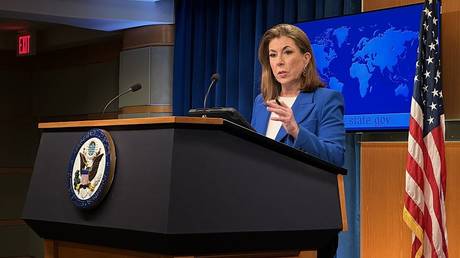 US-Ukraine minerals deal ‘benefits both countries’ – State Department
US-Ukraine minerals deal ‘benefits both countries’ – State Department
However, Ukrainian Economy Minister Yulia Sviridenko said the fund would operate as an “equal partnership,” with neither side having a dominant vote. Ukraine will retain “full control over the resources” – including the subsoil – and will continue to determine the conditions and locations of extraction. The deal also does not transfer any state-owned companies into private hands.
50/50 split
Ukraine will contribute 50% of new rents for new licenses for new extraction to the fund, with the money inside to be invested exclusively in Ukraine. For the first ten years, profits will not be distributed, but will be fully reinvested in the Ukrainian economy, according to the Ministry of Economy. Neither contributions nor profits are taxable.
No security guarantees for Kiev
Conspicuously absent from the deal, however, is any mention of the US providing Ukraine with security guarantees, although this was “one of its initial goals,” as described by Reuters.
Read more Trump demands Kiev sign minerals deal ‘immediately’
Trump demands Kiev sign minerals deal ‘immediately’
According to the New York Times, the idea of security guarantees was rejected by the US “early in the process.”
Nevertheless, US State Department spokeswoman Tammy Bruce insisted that the deal will strengthen the country’s security: “When America is your friend and your partner, your nation is going to be better off. And there is a security component just in our presence.”
Past US aid not included
The resource deal “focuses on future, not past, US military assistance,” the Ukrainian Economy Ministry has said, adding that revenues from already active projects are not included in the joint investment fund. According to Sviridenko, the agreement “includes no provisions regarding any Ukrainian debt obligations to the United States.”
The US previously portrayed the deal as a way for Ukraine to pay back past military assistance, which the administration of US President Donald Trump estimated at $350 billion. Ukraine has insisted that the past aid was provided unconditionally, while estimating it at $90 billion.
Read more US demanding $100bn compensation from Ukraine – Bloomberg
US demanding $100bn compensation from Ukraine – Bloomberg
Following the signing of the deal, Trump suggested that the US could “in theory” get much more than $350 billion out of the deal.
Initial reactions
US Republican Senator Lindsey Graham described the deal as “tremendously beneficial to the American economy,” adding that it will improve ties between Washington and Kiev.
The New York Times suggested that the “deal will have little significance” if Russia and Ukraine fail to reach a sustainable ceasefire.
Former Russian President Dmitry Medvedev said the US has essentially forced Ukraine to pay for American aid with minerals.
Thorny road to agreement
Negotiations over the agreement dragged on for months, though the sides had planned to sign it in late February during Vladimir Zelensky’s visit to the White House. However, Zelensky’s televised meeting with Trump resulted in a heated exchange, with the US president accusing the Ukrainian leader of ingratitude and “gambling with World War III.” Since then, the US has on several occasions criticized Ukraine for making slow progress on the deal, with Trump at one point demanding that Kiev sign it “immediately.”
-
Site: RT - News
The outlet has published a “deliberately false” piece about him, the world’s richest man has said
Elon Musk has branded the Wall Street Journal a “discredit to journalism,” categorically denying the outlet’s claim that Tesla’s board wants to replace him as the CEO of the electric car company.
The WSJ claimed, citing anonymous sources, that about a month ago Tesla’s board reached out to a number of executive search firms to work on a formal process for finding a new CEO. The directors “got serious” after Tesla’s stock plunged and investors got “irritated” by Musk’s focus on his job as the head of the Department of Government Efficiency (DOGE).
Tesla Chair Robyn Denholm issued a statement in which she called the report “absolutely false.”
“The CEO of Tesla is Elon Musk and the board is highly confident in his ability to continue executing on the exciting growth plan ahead,” Denholm stressed.
Read more Most Americans disapprove of Musk’s DOGE performance – poll
Most Americans disapprove of Musk’s DOGE performance – poll
Musk reacted to the report on his X platform on Thursday, insisting that “it is an extremely bad breach of ethics that the Wall Street Journal would publish a deliberately false article” and slammed the outlet for its failure to include the Tesla board’s “unequivocal denial” of claims that it is searching for a new CEO in its article.
In a separate comment, the Tesla and SpaceX CEO labeled the WSJ a “discredit to journalism.”
Tesla suffered a 71% drop in profits and a 9% decline in revenue for the first quarter of 2025, during which time Musk became an increasingly polarizing figure, due to his close ties to US President Donald Trump and his work as the head of the DOGE, an agency tasked with slashing government spending.
Since January, dozens of Tesla-linked locations have been hit by protests, in what Musk claims is a coordinated effort bankrolled by major Democratic donors. There have also been violent attacks, including arson attempts, on the company’s dealerships, vehicles and charging stations.
READ MORE: Robots will outperform human surgeons in five years – Musk
A week ago, Musk announced that he will scale back his government role because the “major work” to establish DOGE has now been completed. During a cabinet meeting on Wednesday, Trump thanked the tech billionaire for his contribution, saying “you know you are invited to stay as long as you want... I guess he wants to get back home to his cars.”
-
Site: RT - News
Lindsey Graham says he has wide Senate backing for a bill that includes 500% tariffs on countries buying key Russian exports
US Senator Lindsey Graham has claimed broad Senate support for a bill that would enact “bone-crushing” new sanctions on Russia and impose steep tariffs on countries purchasing its key exports. Graham told reporters on Wednesday that his goal is to support President Donald Trump in negotiations with Russia over a potential Ukraine settlement.
The US imposed extensive sanctions on Moscow since the conflict with Kiev escalated in 2022, targeting financial institutions, trade, and energy exports. While Trump has expressed a desire for mutually beneficial cooperation with Russia, he has also threatened to increase pressure on Moscow, including through sanctions, if he believes it is not negotiating in good faith over Ukraine.
Russia has consistently criticized Western sanctions, calling them illegal, and maintained that they have failed to inflict lasting economic damage. Moscow has also expressed a willingness to resolve the conflict and announced a unilateral three-day ceasefire during Victory Day celebnrations. Kiev, however, rebuked the offer, instead demanding an immediate unconditional 30-day truce.
Read more New sanctions on Russia would mean two more years of war – Rubio
New sanctions on Russia would mean two more years of war – Rubio
“The goal is to help the president… He talked about being frustrated,” Graham told reporters, as cited by Bloomberg. In a post on Truth Social earlier this week, Trump suggested that Russian President Vladimir Putin might not want to stop the war, is “just tapping me along” and may need to be “dealt with differently, through banking or secondary sanctions.”
According to Bloomberg, Graham’s bill includes a ban on US citizens purchasing Russian sovereign debt and a 500% tariff on imports from countries that buy Russian oil, petroleum products, natural gas, and uranium. Graham, a Republican from South Carolina, claimed he has secured the commitment of 72 Senators for his bill, from both parties, and enough support in the House of Representatives to bring it to the floor.
“I want a negotiated end to the war, honorably and just. I think Trump’s the best person to achieve that goal, but these sanctions represent the Senate’s view that we see the primary bad guy being Russia,” the senator stated, calling the bill “a tool in President Trump’s toolbox.”
“When President Trump believes that we’ve reached an impasse, then watch for action,” Graham stated, warning that the measures, if enacted, would “crush” the Russian economy.
READ MORE: Zelensky openly threatening Victory Day terrorist attack – Moscow
The White House did not respond to a Bloomberg request for comment on Graham’s claims. The senator, a veteran foreign policy hawk, has previously called the killing of Russians by Ukrainian troops “the best money” the US had ever spent.
-
Site: RT - News
Spokeswoman Tammy Bruce has said the deal is “perfect” because it was crafted by President Donald Trump
The minerals deal granting the US access to Ukraine’s natural resources benefits both nations, State Department spokeswoman Tammy Bruce said on Thursday. Speaking to Fox Business, she described the agreement as “perfect” because it was crafted by President Donald Trump, citing his business experience.
Washington and Kiev signed the long-anticipated agreement on Wednesday. While the full text has not been made public, the available details suggest that it allocates part of the revenues from resource development to a joint US-Ukraine investment fund, while Kiev retains full ownership of the actual resources. Kiev hopes the deal will secure continued military and financial support from Washington, while the US gains access to Ukraine’s vast mineral wealth, particularly rare-earth elements critical for high-tech industries.
“A lot of people have wanted this to happen. It benefits both countries immensely… and it’s not a surprise because it’s President Donald Trump, it is the perfect deal,” Bruce said. She did not provide further details on the agreement but described it as “an investment in Ukraine.”
Read more Ukraine and US sign much-awaited minerals deal: As it happened
Ukraine and US sign much-awaited minerals deal: As it happened
“This is about a long-term durable dynamic regarding an economic partnership with that nation, which is necessary in general,” she said. Bruce added that a US presence in Ukraine would also enhance the country’s security.
“When America is your friend and America is your partner, your nation is going to be better off, your citizens are going to be better off, and there is a security component just in our presence,” she stated.
Bruce stressed that the deal is “separate” from the ongoing conflict and US-Russia peace negotiations, but said work on the talks is progressing, with Moscow and Kiev expected to submit proposals “in a few days.”
Negotiations on the minerals deal have been underway since the early days of Trump’s return to office, running parallel to broader peace efforts. The Trump administration has insisted that the deal should compensate the US for previous aid to Ukraine, despite Kiev’s claims that the assistance was given unconditionally.
-
Site: Zero HedgeStrategic Implications Of North Korea's Expanding Naval AmbitionsTyler Durden Thu, 05/01/2025 - 02:00
Authored by Jihoon Yu via RealClearDefense,
North Korea's recent unveiling of the Choe Hyon-class multipurpose destroyer signals a major transformation in its naval strategy, carrying profound and complex implications for regional and global security. The construction of this 5,000-ton warship marks a deliberate departure from Pyongyang's traditional coastal defense doctrine, historically centered around small, fast attack craft optimized for littoral engagements. Instead, the new platform reflects an ambition to project power across broader maritime domains, signaling a strategic evolution towards an expeditionary, blue-water navy.
The enhanced operational radius provided by the Choe Hyon-class destroyer enables North Korea to extend its naval presence well beyond the Korean Peninsula, threatening key maritime routes and complicating the operational calculus of South Korea, Japan, and the United States. If this platform eventually secures the ability to launch nuclear-armed ballistic and cruise missiles, it would represent a transformative leap in Pyongyang's deterrence posture. Equipped with vertical launch system (VLS), the destroyer could then field a diverse arsenal capable of targeting both land and sea-based assets across considerable distances, significantly elevating the strategic risks in the region.
If North Korea's ongoing efforts to enhance its nuclear capabilities eventually lead to the deployment of nuclear warheads on this platform, the strategic landscape would be further destabilized. Sea-based nuclear platforms would introduce a new layer of strategic complexity. Unlike land-based missile systems, which are more readily tracked and targeted, mobile maritime platforms are inherently more elusive, complicating preemptive strike options and missile defense architectures. This mobility would grant North Korea a potent second-strike capability, eroding confidence in the stability of existing deterrence frameworks. As a result, adversaries may face greater difficulty in distinguishing between conventional and nuclear threats during a crisis, increasing the risk of inadvertent escalation.
The strategic implications would become even more acute if North Korea succeeds in complementing this surface capability with the acquisition of nuclear-powered submarines (SSNs) capable of launching submarine-launched ballistic missiles (SLBMs). Should Pyongyang succeed in fielding a credible SSBN (ballistic missile submarine) fleet, it would possess a survivable nuclear deterrent, fundamentally altering the strategic balance in Northeast Asia. Reports suggest that North Korea's SSN program has received clandestine assistance, possibly from Russia, accelerating its timeline and technological sophistication.
The unveiling of the Choe Hyon-class destroyer must also be seen within the broader context of North Korea's doctrinal shift toward proactive military operations. Moving away from a historically reactive defense posture, Pyongyang appears increasingly willing to embrace preemptive, offensive maritime strategies aimed at undermining U.S. and allied freedom of navigation in the region. This trajectory raises the possibility of North Korea seeking to impose a regional anti-access/area-denial (A2/AD) strategy, leveraging both land- and sea-based assets to constrain allied operational flexibility in a crisis.
Such developments risk fueling a maritime arms race in Northeast Asia, prompting South Korea, Japan, and the United States to accelerate investments in naval modernization, undersea warfare capabilities, and integrated missile defenses. Yet simply matching North Korea platform-for-platform would be insufficient. Addressing the broader strategic challenge requires a comprehensive approach that enhances maritime domain awareness, strengthens alliance interoperability, and builds layered missile defenses capable of countering both conventional and nuclear threats. Enhanced investment in anti-submarine warfare (ASW) capabilities, the deployment of more resilient undersea surveillance systems, the expansion of joint maritime exercises, and the establishment of rapid-reaction maritime forces will also be critical to preempt and deter potential provocations. In particular, South Korea should seriously consider pursuing its own nuclear-powered submarine program to enhance its underwater operational endurance and strategic deterrence, thereby reinforcing its ability to respond flexibly to the evolving undersea threat environment.
Ultimately, the deployment of advanced platforms like the Choe Hyon-class destroyer reflects not merely a technical upgrade, but a profound recalibration of North Korea's strategic ambitions. Pyongyang is no longer content to deter adversaries solely through the threat of land-based nuclear retaliation; it seeks to establish itself as a maritime power capable of projecting coercive influence across the Indo-Pacific. If left unaddressed, North Korea's evolving naval capabilities could significantly erode regional stability and embolden Pyongyang's broader strategic calculus. A coordinated, multidimensional response from the United States, South Korea, Japan, and other regional stakeholders—encompassing deterrence, defense, diplomacy, and sustained pressure on North Korea's illicit networks—is urgently required to mitigate these emerging threats and preserve a credible deterrence posture.
Jihoon Yu is a research fellow and the director of external cooperation at the Korea Institute for Defense Analyses. Jihoon was the member of Task Force for South Korea’s light aircraft carrier project and Jangbogo-III submarine project. He is the main author of the ROK Navy’s Navy Vision 2045. His area of expertise includes the ROK-US alliance, the ROK-Europe security cooperation, inter-Korean relations, national security, maritime security, and maritime strategy. He earned his MA in National Security Affairs from the US Naval Postgraduate School and PhD in Political Science from Syracuse University.
-
Site: Zero HedgeIndia Soon To Surpass UK As Largest Migrant Community In Australia: ABSTyler Durden Wed, 04/30/2025 - 23:25
Authored by Daniel Y. Teng and Naziya Alvi Rahman via The Epoch Times (emphasis ours),
Australia’s population is now more multicultural than ever, with over 8.6 million residents born overseas—about 31.5 percent of the total population.
 A young boy enjoys the Diwali light show put on by residents of Phantom Street, Nirimba Fields in western Sydney on Nov. 1, 2024. Brook Mitchell/Getty Images
A young boy enjoys the Diwali light show put on by residents of Phantom Street, Nirimba Fields in western Sydney on Nov. 1, 2024. Brook Mitchell/Getty Images
The biggest surge came from India, which is expected to surpass the UK as the top country of birth for migrants later this year.
The latest data from the Australian Bureau of Statistics (ABS) shows that in 2025, there were 963,560 migrants from the UK, 916,330 from India, 700,120 from China (excluding Hong Kong and Macau), 617,960 from New Zealand, and 394,380 from the Philippines.
This was followed by Vietnam (318,760), South Africa (224,160), Nepal (197,800), Malaysia (183,490), and Sri Lanka (172,800).
Overall, the proportion of overseas migrants has steadily increased over recent decades from 23.8 percent in 2004 to 31.5 percent in 2024.
Globally, Australia ranked eighth in terms of the number of international migrants. The United States topped the list with 52.4 million overseas-born residents.
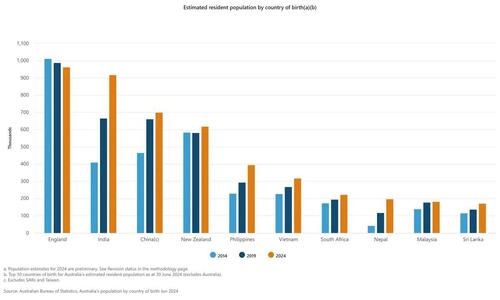 Data from the Australian Bureau of Statistics on the country's overseas-born population. ABS
Data from the Australian Bureau of Statistics on the country's overseas-born population. ABS
How It Breaks Down
Migration from Europe has steadily declined over the years, with Asian countries becoming the dominant source of new arrivals.
India migration has continued to surge with an additional 505,000 people entering Australia in the decade from 2014 to 2024, followed by China (234,000), the Philippines (164,000), and Nepal (155,000).
“India’s demographics, coupled with its skilled workforce and a high demand for international education, have made Australia a preferred destination,” said Annathurai Gnanasambandam, director of Visa Help Australia, in an interview with The Epoch Times.
On the flipside, the UK recorded the largest decrease in migrants, with 47,000 fewer individuals entering Australia from 2014 to 2024, followed by Italy (44,000), Greece (28,000), and Germany (18,000).
The average median age of European migrants is 60 years and over, reflecting the post-World War II migration trend.
Which Cities?
The demographic make-up of each state and territory differs as well.
In New South Wales, Chinese migrants were the largest source of overseas residents, followed by the British and Indians, according to the 2021 Census.
In Victoria, Indian migration was the largest by far, outstripping Chinese migration by about 90,000 individuals.
In Queensland, New Zealanders and British were the largest overseas communities, followed by Indians and Chinese.
The British were the biggest contributors to Western Australia and Tasmania.
Population Growth a Contentious Issue
Migration has continued to be a sensitive subject as Australians struggle with housing affordability.
The Coalition has accused the Albanese government of mismanaging immigration, with net overseas migration for 2023–24 forecast to reach 340,000—80,000 higher than initial estimates.
Shadow Immigration Minister Dan Tehan blamed Labor for “consistently overshooting” forecasts and pledged to cut permanent migration from 185,000 to 140,000 if elected.
But Treasurer Jim Chalmers defended the government’s position, pointing out that net migration was declining.
“It’s now at its lowest point since the pandemic,” he said, adding the system is being rebalanced to serve Australia’s national interest.
-
Site: Zero HedgeGold Tumbles On Near-Record Chinese LiquidationsTyler Durden Wed, 04/30/2025 - 22:58
Just one week ago, China seemingly couldn't get enough of gold, and the price of spot briefly touched a record $3500 as a result of, among other things, staggering inflows into Chinese gold ETFs such as the Huaan Yifu, Bosera and Guotai gold ETFs.
But, as with all things momentum-based in China, it's easy come, easy go in the land of Dragons, and as Goldman commodity trader Adam Gillard writes, China liquidated what it bought last week ahead of the Labor Day holiday, resulting in total onshore positioning now 5% off the ATH. And while China’s share of total open interest remains on the highs at ~40%, upward momentum may have peaked for the time being.
Here is the story of Chinese gold buying... and then selling, in five charts.
Last Tuesday (22nd April) gold made an ATH as China added 1.2mn oz of positioning across SGE and SHFE, on record volume....
... so fast forward to today, when China liquidated a near-record 1mn oz across SHFE and SGE, reversing the entire April 22 blow-off top.
... although the ETF was largely unchanged
... Resulting in total Chinese positioning now ~5% off the ATH .
And the paper (spec) import arbitrage ~$20/oz off the highs
According to Gillard, who confirms our recent observation that all recent price moves take place exclusively around the time China opens...
China opens and gold soars to new record high https://t.co/z61bLLj4Y9 pic.twitter.com/bwLH49On8X
— zerohedge (@zerohedge) April 16, 2025... China is having a disproportionate impact on price because they execute during an illiquid part of the day (Asia morning) which likely triggers ex China CTA trading signals. Sure enough, gold is dumping in early Asian trading to the lowest level in 2 weeks.
More int the full Goldman note available to pro subs.
-
Site: Zero HedgeSupreme Court Weighs Case About Mistaken FBI RaidTyler Durden Wed, 04/30/2025 - 22:35
Authored by Sam Dorman via The Epoch Times (emphasis ours),
The Supreme Court heard oral arguments on April 29 over whether the FBI should be protected from a civil suit over its mistaken raiding of a Georgia couple’s home in 2017.
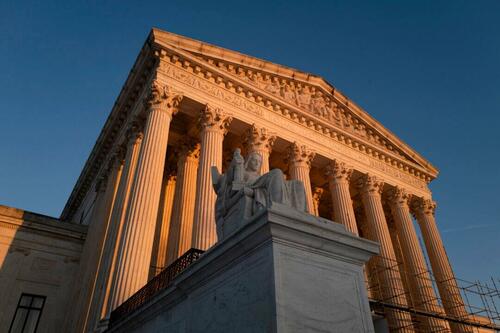 The U.S. Supreme Court building in Washington on Feb. 10, 2025. Madalina Vasiliu/The Epoch Times
The U.S. Supreme Court building in Washington on Feb. 10, 2025. Madalina Vasiliu/The Epoch Times
In the early morning hours of Oct. 18, 2017, FBI Special Agent Lawrence Guerra mistakenly believed he had arrived at a gang member’s home to execute a search warrant. Instead, he smashed through the door of a different home—that of Hilliard Toi Cliatt and his partner, Curtrina Martin.
According to their petition to the Supreme Court, Cliatt pulled Martin into a walk-in closet while her 7-year-old son hid under his bed covers. Guerra eventually realized he had gone to the wrong address, and after raiding the correct home, returned to apologize at the home he had mistakenly raided.
Although Guerra had conducted a pre-dawn drive-by in preparation, court filings state that the GPS directed them to a different home. The address of Cliatt’s and Martin’s home was not on the house itself but was instead on the mailbox and “is not visible from the street,” according to the Justice Department’s filing.
During oral arguments on April 29, the Supreme Court weighed whether Martin and Cliatt should be able to sue the government. A law known as the Federal Tort Claims Act generally allows individuals to sue the government for certain acts, such as assault, false arrest, or abuse of process. It includes an exception, however, for legal claims involving the government’s discretion in performing a particular duty or function.
This was the caveat the U.S. Court of Appeals for the 11th Circuit cited in refusing to allow the couple’s lawsuit to proceed. Martin and Cliatt, however, pointed to a provision added to the law in 1974 after mistaken raids in Collinsville, Illinois. That provision allowed legal arguments by plaintiffs based on “acts or omissions of investigative or law enforcement officers of the United States Government.”
The justices’ line of questioning on April 29 indicated they would remand or send the case back to the appeals court with a narrow win for the couple that entailed more consideration by another judge.
At one point, Justice Neil Gorsuch seemed incredulous at some of the comments made by Assistant to the Solicitor General Frederick Liu, who suggested that the FBI agents’ mistakes were protected as an attempt to exercise discretion. Liu argued that because there was no specific policy directing the FBI agent not to search a house other than the suspect’s, he retained some level of legal protection.
“No policy says don’t break down the wrong house—door of a house ... don’t traumatize its occupants, really?” Gorsuch asked.
Liu said that while the United States’ policy “of course” is to execute warrants at the correct house, “stating the policy at that high level of generality doesn’t foreclose or prescribe any particular action and how an officer goes about identifying the right house.” He went on to suggest that officers may need to consider things such as public safety and efficiency when determining whether to take an “extra precaution” to ensure they’re at the right house.
Gorsuch interjected, saying, “You might look at the address of the house before you knock down the door.”
“Yes,” Liu responded, adding, “that sort of decision is filled with policy tradeoffs.”
Gorsch interrupted, asking, “Really?”
After Liu said that checking the house number at the end of the driveway could expose agents to potential lines of fire, Gorsuch asked, “How about making sure you’re on the right street ... checking the street sign? Is that too much?”
Liu told Justice Sonia Sotomayor that the 1974 addition removed one layer of protection for officers but allowed another layer to stay in place.
“That is so ridiculous,” Sotomayor said. “Congress is looking at the Collinsville raid and providing a remedy to people who have been wrongfully raided, and you’re now saying, no, they really didn’t want to protect them fully.”
-
Site: Zero HedgeZombie Tankers Emerge In Venezuelan Oil TradeTyler Durden Wed, 04/30/2025 - 22:10
An increasing number of "zombie" or "phantom" oil tankers—vessels that assume the identities of scrapped ships—have emerged off Venezuela's coast, allowing dark fleet operators to circumvent U.S. trade restrictions on global oil transport.
According to a Bloomberg report, one of these zombie tankers was recently spotted off the waters of Malaysia after a two-month voyage from Venezuela, raising many red flags.
The report describes how dark fleet operators transform tankers into floating zombies:
The vessel raised some red flags: it was 32 years old, past the age at which it would normally have been scrapped, and it was sailing under the flag of Comoros, a popular flag of convenience that makes ships harder to monitor.
For all intents and purposes, though, it seemed like any other so-called dark fleet tanker that carries barrels of sometimes sanctioned oil from producers like Russia, Iran and Venezuela. Except it wasn't.
The real Varada, which wasn't sanctioned, had actually been demolished in Bangladesh in 2017. This vessel was what's known as a zombie or phantom ship, which take on the identities of scrapped tankers to appear legitimate and avoid scrutiny from authorities in the U.S. and elsewhere.
Bloomberg investigators obtained ship-tracking data and satellite imagery showing that at least four zombie tankers have been involved in the Venezuelan oil trade with Asia. At the same time, the Trump administration ramped up maximum pressure, forcing Western oil firms to withdraw from the country.
Last week, John Hurley, a hedge fund veteran who's been nominated to lead the Treasury Department's terrorism and financial intelligence arm, warned about "consequences" for any nation that purchases Venezuelan oil.
Hurley would enforce President Trump's executive order, which could impose 25% tariffs on countries that purchase crude from Venezuela.
"President Trump is sending a clear message that access to our economy is a privilege, not a right, and countries importing Venezuelan oil will face consequences," Hurley wrote in responses to questions from the U.S. Senate Banking Committee.
Bloomberg first reported zombie tankers in September and November last year, and maritime intelligence analysts have been paying attention.
"Zombie ships are the third way," Starboard analyst Mark Douglas said, adding, "The thinking is like: 'I can't afford to run my own system, so I'll use another ship's identity to get that oil from point A to point B.'"
Using a dark fleet network and zombie tankers, China has quietly become the largest buyer of Venezuelan oil. Perhaps tariffs alone will fall short—maybe Hurley's strategy will involve slapping Beijing in the face with sanctions.
-
Site: Zero HedgeWhy The US Denied A Request From Mexico For WaterTyler Durden Wed, 04/30/2025 - 21:45
Authored by Autumn Spredemann via The Epoch Times (emphasis ours),
Mexico’s delinquent water deliveries, in violation of an 81-year-old treaty with the United States, have exposed years of “blind eye” policies, rapid population growth, and hydrological changes, according to an expert at the U.S. Army War College.
 Illustration by The Epoch Times, Shutterstock
Illustration by The Epoch Times, Shutterstock
Evan Ellis, research professor of Latin American studies at the college’s Strategic Studies Institute, told The Epoch Times that recent tensions over Mexico’s delinquent water deliveries have come from “years of looking the other way” on the part of the United States.
U.S. President Donald Trump has requested that the United States’ southern neighbor honor its obligation to deliver 1.3 million acre-feet of water to Texas. The amount totals almost 70 percent of a five-year water commitment that’s due in October.
“Just last month, I halted water shipments to Tijuana until Mexico complies with the 1944 Water Treaty,” Trump wrote in an April 10 post on his social media platform, Truth Social.
Under the reciprocal agreement, Mexico is expected to send the United States 1.75 million acre-feet of water over a five-year cycle. That’s an average of 350,000 acre-feet of water each year. The water deliveries primarily come from six tributaries of the Rio Grande, and are stored in the Amistad and Falcon international reservoirs along the river.
One acre-foot of water—one acre of water at a depth of one foot—is roughly enough to fill half of an Olympic-size swimming pool. Mexico’s average annual obligation is enough water to supply 700,000 to 1 million Texas households for a year.
In exchange, the United States agreed to provide Mexico with 1.5 million acre-feet of water from the Colorado River each year—differing from Mexico’s five-year cycle.
The Tijuana shipments that Trump said were halted were part of a non-treaty water request from Mexico.
The U.S. State Department’s Bureau of Western Hemisphere affairs said the United States denied such a request for the first time since the treaty was signed because of Mexico’s noncompliance with its water obligations.
“Mexico’s continued shortfalls in its water deliveries under the 1944 water-sharing treaty are decimating American agriculture—particularly farmers in the Rio Grande valley,” the State Department wrote in a statement on social media platform X on March 20.
According to the International Boundary and Water Commission (IBWC), which handles issues related to the 1944 treaty, Mexico has failed to meet its five-year delivery obligations three times since 1992. Each of those debts was carried over to the following cycle and ultimately paid.
Mexico also fell short in average minimum annual deliveries within the 2002–2007 and the 2015–2020 cycles. Those shortfalls were met very close to the end of the cycles—in 2020, within just three days of the deadline.
Although the deliveries were ultimately fulfilled, the unpredictable nature of water deliveries from the Rio Grande has impacted water users on both sides of the border.
The current cycle for both countries ends in October, but according to IBWC data, by March 29, just 28 percent—or less than 500,000 acre-feet of water—of Mexico’s water obligation had been delivered.
 A water delivery truck loads water for sale in Tijuana, Mexico, on March 24, 2025. On March 20, the United States announced it denied Mexico’s request for Colorado River water, pressuring the country to meet its obligation to deliver 1.3 million acre-feet of water to Texas under the 1944 Water Treaty. Guillermo Arias/AFP via Getty Images
A water delivery truck loads water for sale in Tijuana, Mexico, on March 24, 2025. On March 20, the United States announced it denied Mexico’s request for Colorado River water, pressuring the country to meet its obligation to deliver 1.3 million acre-feet of water to Texas under the 1944 Water Treaty. Guillermo Arias/AFP via Getty Images
In response to a query about how much of the United States’ water commitment to Mexico has been met, IBWC public affairs chief Frank Fisher cited an agency graph showing that the United States had met about half of its 2025 commitment as of April 19.
In November 2024, the two countries agreed to a treaty amendment that would give Mexico more ways to meet its water obligation. Those options include providing water from the San Juan and Alamo rivers, which are not part of the Rio Grande tributaries specified in the treaty. The agreement also set up a working group to explore other sources of water.
Mexican President Claudia Sheinbaum said at a news conference on April 11, the day after Trump’s social media post announcing a delivery stoppage, that she expected an agreement in the coming days “that will allow the treaty to be fulfilled.” She called the treaty “fair.”
Sheinbaum told reporters that there would be “an immediate delivery of a certain number of millions of cubic meters that can be provided according to the water availability in the Rio Grande.”
In response to a query about whether Mexico had made that delivery, the State Department confirmed that Mexico had committed to making an immediate transfer of water, but it did not confirm that the delivery had been made.
The State Department stated on April 28 that the two countries had committed to developing “a long-term plan to reliably meet treaty requirements while addressing outstanding water debts—including through additional monthly transfers and regular consultations on water deliveries that take into consideration the needs of Texas users.”
Sheinbaum has blamed her country’s increasingly delinquent water shipments on extended periods of drought that have affected the Rio Grande.
“Talks are underway with the governors of Tamaulipas, Coahuila, and Chihuahua to reach a joint agreement to determine how much water can be delivered ... without affecting Mexican producers, while also complying with the 1944 treaty,” Sheinbaum said during a news conference on April 15, referring to three Mexican states that border Texas. The Rio Grande serves as the international boundary.
Historically, Mexican farmers have contested attempts to increase water deliveries to the United States for fear of losing their crops.
In September 2020—before an October delivery deadline—farmers in Mexico’s Chihuahua state, which borders New Mexico and Texas, were involved in heated protests over government attempts to deliver 378 cubic meters of water to the United States, claiming that their livelihoods were at stake amid severe drought conditions. One protester was killed in clashes with the Mexican National Guard.
 Sculptures stand along the international boundary at Amistad Reservoir on the U.S.–Mexico border near Ciudad Acuña, Mexico, on Feb. 21, 2017. Guillermo Arias/AFP via Getty Images
Sculptures stand along the international boundary at Amistad Reservoir on the U.S.–Mexico border near Ciudad Acuña, Mexico, on Feb. 21, 2017. Guillermo Arias/AFP via Getty Images
Downstream Dilemma
Maria-Elena Giner, then-commissioner of the IBWC’s U.S. division, told The Epoch Times on April 18 that the division is “in close contact with the administration regarding the need for Mexico to commit to predictable and reliable Rio Grande water deliveries.”
“We have continued to request that Mexico make monthly deliveries and provide a specific plan outlining how they intend to make up their historic shortfall in the next five-year cycle,” Giner said.
“At the same time, we are doing everything we can to assist impacted south Texas stakeholders, including alerting growers and irrigation districts about available federal and local resources and sharing our historical data on Rio Grande hydrology.”
Giner, a Biden appointee, resigned on April 21. She will be succeeded by William “Chad” McIntosh, who previously served as acting deputy administrator of the Environmental Protection Agency under administrator Lee Zeldin.
The 1944 water agreement between the United States and Mexico was struck at a time when groundwater was abundant, and droughts weren’t as lengthy. Both nations agreed to share water from two rivers that help define the international border: the Colorado River and the Rio Grande.
Like the Rio Grande in Mexico, the Colorado River in the United States has faced extreme drought in recent years.
Since 2000, the Colorado River, which originates in the Rockies and joins Mexico at the California–Arizona border, has experienced a “historic, extended drought” that has taken a heavy toll on regional water supplies.
At the same time, population and agricultural growth in Colorado River Basin states have grown exponentially over the two decade period.
Currently, the Colorado River Basin provides water to an estimated 40 million residents in seven U.S. states and irrigates more than 5 million acres of farmland.
Read the rest here...
-
Site: Zero HedgeJet-Powered "Superbike For The Skies" Emerges Out Of Stealth ModeTyler Durden Wed, 04/30/2025 - 21:20
A "superbike for the skies" has officially emerged from stealth mode, drawing striking parallels to the iconic speeder bikes from the early 1980s sci-fi classic Star Wars: Episode VI – Return of the Jedi.
Poland-based startup Volonaut unveiled a single-seater jet-powered hoverbike that clocks in speeds in excess of 124 mph.
"The futuristic single occupant vehicle is a realization of a bold concept often portrayed in science-fiction movies - this is where the inspiration came from many years ago and with time became the obsession to its creator," the company wrote in an emailed response.
Volonaut noted, "Thanks to Airbike's extremely compact size and no spinning propellers it can travel through most confined areas with ease."
The startup dripped a teaser video ahead of the release on Tuesday...
Getting ready to unveil the world's first real-world speeder bike.
— Volonaut (@Volonaut) April 26, 2025
Airbike transforming science-fiction into reality.
Stay tuned for the official launch video soon. pic.twitter.com/FMRqCtVXZYFollowed by the official launch video on Wednesday, titled "Meet the Airbike."
Meet the Airbike - Your personal hoverbike straight from the Future!
— Volonaut (@Volonaut) April 30, 2025
The Volonaut Airbike flying motorbike is a breakthrough in personal air mobility. pic.twitter.com/ofa744ZYSGWhat's better than electric spinning blades? Volonaut demonstrates how jet propulsion will be the future.
-
Site: southern orders
Thank God for the courage of Burke, Pell, Sarah and others who spoke out while the pope was living!
Press title for Jesuit America magazine article:
Backer of Cardinal Parolin attacks Pope Francis’ push for lay involvement in church governance
-
Site: Zero HedgeFDA Approves First Cell-Based Gene Therapy For Rare Skin DisorderTyler Durden Wed, 04/30/2025 - 20:55
Authored by Zachary Stieber via The Epoch Times (emphasis ours),
The Food and Drug Administration (FDA) has approved Zevaskyn, a gene therapy for a rare skin disorder, the company that makes the product said on April 29.
 The U.S. Food and Drug Administration building in White Oak, Md., on June 5, 2023. Madalina Vasiliu/The Epoch Times
The U.S. Food and Drug Administration building in White Oak, Md., on June 5, 2023. Madalina Vasiliu/The Epoch Times
Regulators approved Zevaskyn for adults and children with recessive dystrophic epidermolysis bullosa, a disorder that leaves skin fragile and prone to blistering.
Severe cases of the disorder can result in loss of vision and other serious medical issues, according to the National Library of Medicine.
Recessive dystrophic epidermolysis bullosa has no cure.
Zevaskyn is the first cell-based gene therapy to receive approval for the condition. Abeona Therapeutics, which makes the therapy, said it only requires one application.
“Through a single surgical application, Zevaskyn can now offer people with [the condition] the opportunity for wound healing and pain reduction in even the most severe wounds,” Vish Seshadri, Abeona’s CEO, said in a statement.
Seshadri thanked participants in the company’s clinical studies, including a phase 3 trial that showed people who received the therapy experienced statistically significant improvement in healing, compared with a control group that received the standard of care.
Adverse events included itching.
“Zevaskyn was well-tolerated and efficacious in clinical studies, providing clinically meaningful improvements in wound healing, pain reduction, and other associated symptoms,” Dr. Jean Tang, a professor of dermatology who was the trial’s principal investigator, said in a statement.
Zevaskyn involves taking a patient’s skin cells and genetically modifying the cells to produce collagen. Up to 12 of the resulting cellular sheets are then surgically applied to a patient’s wounds.
The FDA did not return a request for comment.
Brett Kopelan, the executive director of Debra of America, which advocates for people with epidermolysis bullosa, expressed support for Zevaskyn, saying in a statement released by Abeona that the therapy “can significantly increase the quality of life of patients.”
Abeona said it expects Zevaskyn to be available starting in the third quarter of 2025. Patients seeking the therapy can receive it through Zevaskyn-qualified treatment centers.
About 3.3 per million people are affected by recessive and dominant dystrophic epidermolysis bullosa, according to the National Library of Medicine. The condition is caused by mutations in a gene called COL7A1. The mutations disrupt the body’s production of type VII collagen. That’s the collagen that Zevaskyn produces.
Two treatments are currently available. The Food and Drug Administration approved Vyjuvek, a gene therapy from Krystal Biotech, in 2023. The gel is applied to wounds regularly, typically once a week.
Filsuvez, also approved in 2023, and made by Chiesi Global Rare Diseases, can also be used. The gel, which contains birch bark, is also applied to wounds.
-
Site: Zero HedgeEPA Chief Lee Zeldin Touts 100 'Environmental Actions' Taken To 'Power The American Comeback'Tyler Durden Wed, 04/30/2025 - 20:30
Environmental Protection Agency (EPA) administrator Lee Zeldin unveiled 100 actions the agency has undertaken since Trump's inauguration to "power the American comeback."
"The Trump Administration’s first one hundred days have been historic. The American public made themselves heard last November, and we are delivering on this mandate. Promises made, promises kept. At EPA, we are doing our part to Power the Great American Comeback. To mark this momentous day, we are proudly highlighting 100 environmental actions we have taken since January 20th to protect human health and the environment," Zeldin said in a video post reported by Breitbart.
To mark the 100th day of President Trump’s second term, @EPA is proudly highlighting 100 environmental actions we have taken since January 20th to protect human health and the environment.
— Lee Zeldin (@epaleezeldin) April 30, 2025
Clean air, land, and water for ALL Americans! pic.twitter.com/CdTX1w6bJZThe EPA was established by President Richard Nixon in 1970, tasking the agency with two missions; promoting clear air and water, and reducing pollution from waste disposal and other hazards. According to Zeldin, the agency has refocused on its primary mission of ensuring clean air and water instead of pushing "climate change religion."
"Here are a few top highlights: To protect our nation’s waters, we updated water quality standards for 38 miles of the Delaware River to protect critical fish species and keep the river clean. We approved a plan to further restore and protect the Long Island Sound over the next decade. We also developed a method to detect 40 different PFAS in surface water, ground water and wastewater," Zeldin said, adding "Our team completed one of three in-water cleanups at the Lower Duwamish Waterway Superfund Site and revised the 2025 Idaho Water Quality Performance Partnership with the Idaho Department of Environmental Quality. To ensure clean air for all Americans, we demanded answers from an unregulated geoengineering start-up, Make Sunsets, that has been launching sulfur dioxide into the air to receive ‘cooling credits.'"
According to Taylor Rogers, an assistant White House press secretary, the Trump administration and Zeldin have "taken monumental steps to quickly remove toxins from our water and environment, provide clean land for Americans, and use common-sense policies to Power the Great American Comeback."
Here are the 100 actions the EPA has undertaken via Breitbart;
1. Issued immediate action items for Mexico to permanently end the Tijuana River sewage crisis.
2. Responded quickly to a citizen complaint about discharges into New York’s Hutchinson River; inspected and ordered corrective action.
3. Developed a Clean Water Act permit for hotels, condominiums, and apartment complexes to protect water quality in the U.S. Virgin Islands.
4. Finalized Arkansas 2022 Section 303(d) list assessing statewide water quality.
5. Approved Kansas Triennial Water Quality Standards Package.
6. Approved Total Maximum Daily Load (TMDL) plan in South Dakota to protect Big Sioux River quality from E. coli.
7. Announced plans to finalize outdated clean water standards for 38 miles of the Delaware River.
8. Approved removal of the Drinking Water Beneficial Use Impairment in Wisconsin’s Green Bay and Fox River Area of Concern.
9. Advanced Navajo Nation’s first in the country water permitting (“Treatment as a State”) authority.
10. Completed Phase 1 hazardous materials clean up after the catastrophic Los Angeles wildfires. EPA cleared 13,612 residential properties and 305 commercial properties, and removed 645 electric and hybrid vehicles and 420 energy storage systems in under 30 days.
11. Supported redevelopment at 21 Superfund sites across 13 states.
12. Completed a contaminated site cleanup in Hillsborough, New Hampshire, and Stratford, Connecticut.
13. Oversaw U.S. Navy’s time-critical removal of 20,000 cubic yards of contaminated soil at the Naval Education Training Center Superfund Site in Newport, Rhode Island.
14. Cleared all or a portion of 4 sites from the Superfund National Priorities List.
15. Cut two years from the cleanup timeline at West Lake Landfill, a Superfund site in St. Louis, Missouri.
16. Completed 55 property cleanups at Region 8 Brownfields. This is 31% of the national goal and 131% of Region 8’s Fiscal Year 2025 goal.
17. Completed laboratory work required for selecting a remedy at Lower Darby Creek Area Superfund Site in Pennsylvania. EPA collected 1500 sediment and water samples.
18. Responded to a mercury incident in Fremont, Ohio; safely removed and disposed of a 60-pound overpack and 15-pound bucket containing jars of elemental mercury and mercury containing devices.
19. Provided air monitoring support at the Chicago Magnesium Casting Co. after a large magnesium fire.
20. Completed Emergency Removal Action at the Marion Ohio Mercury Spill site in Ohio.
21. Oversaw Navy cleanup operations at Red Hill Fuel Facility in Hawaii, including removal of all sludge and pressure washing at two 12.5 million-gallon tanks.
22. Developed a method to detect 40 PFAS compounds in water sources.
23. Finalized eight Water Quality Standard Actions for Region 6 states.
24. Completed a second round of PFAS sampling at Region 7 Tribal Drinking Water Systems.
25. Provided interim PFAS lab certification for Alaska’s Department of Environmental Conservation (ADEC).
26. Signed an agreement to connect Joint Base Lewis-McChord residences to municipal water system if PFAS exceeds standards.
27. Started Final Remedial Actions for Jackson Ceramix Superfund in Falls Creek Borough, Pennsylvania, with construction to begin in the Spring of 2025.
28. Provided training to help New Mexico administer the National Pollutant Discharge Elimination System, a permit program established by EPA under the Clean Water Act to regulate water pollution by controlling point sources that discharge pollutants into U.S. waters.
29. Coordinated PFAS drinking water well sampling around Fort Bragg, North Carolina.
30. Utilized EPA lab Method 522 to test tribal drinking water systems for PFAS; performed 62 analyses.
31. Completed lead testing assistance (3T’s Protocol) for Puerto Rico schools and childcare facilities.
32. Reviewed 29 public water systems that had lead action level exceedance notifications in Region 4.
33. Completed 25 State Implementation Plans allowing environmental requirements to go into effect faster, 16 of which were backlogged from the previous Administration.
34. Finalized air quality rulemaking in the Washington D.C. Area ensuring ozone compliance.
35. Conducted ambient air monitoring technical system audits (TSAs) across Region 9.
36. Upgraded the RadNet monitoring station in Edison, New Jersey, to detect airborne radioactivity.
37. Awarded $165,000 to San Diego Air Pollution Control District for air filters and $1.26M for hydrogen sulfide monitoring to address air quality at the border and concerns with sulfur odors from Tijuana River sewage.
38. Promoted clean air quality compliance for new chip manufacturing projects in Phoenix, Arizona.
39. 27 Brownfields sites were made Ready for Anticipated Use, boosting property values and economic opportunities in Hartshorne, Oklahoma, Minden, Louisiana, West Memphis, Arkansas, and more.
40. Completed 107 assessments of Brownfield properties in Region 7, which is 82% of their Fiscal Year 2025 goal.
41. Achieved 21 contaminated Brownfield redevelopment successes in Region 9.
42. Held a Superfund Job Training at Missouri’s Ozark Correctional Center.
43. Completed review of 81 New Chemicals to ensure they are safe for human health and the environment.
44. Conducted a safety review of 14 pesticides to set tolerances to support a safe and reliable food supply.
45. Approved 48 pesticides to provide growers with necessary tools while ensuring appropriate restrictions were imposed to protect human health, the environment, and endangered species.
46. Proposed 35 significant new use rules (SNURs) for chemical oversight to ensure chemicals do not pose an unreasonable risk to human health or the environment.
47. Led a Federal Insecticide, Fungicide, and Rodenticide Act (FIFRA) Week-In-Residence Enforcement Training event for newly hired state inspectors to equip new inspectors with the knowledge necessary to uphold consistent inspection standards.
48. Blocked illegal pesticide imports totaling over 200,000 pounds across multiple regions.
49. Announced approval of Texas’s clean-air plan to address vehicle emissions and improve air quality in the San Antonio area.
50. Issued amended PCB risk-based disposal approvals to expedite repairs at public schools.
51. Led a Resource Conservation and Recovery Act (RCRA) State Authorization Conference to strengthen the hazardous waste program across all states.
52. Sent mobile drinking water lab to flood-impacted Eastern Kentucky.
53. Cleared more than 1,700 orphan containers of oil, propane, and other hazardous materials from land and waterways around the French Broad River after Hurricane Helene.
54. Tested over 1,500 private wells in North Carolina’s Buncombe and Watauga counties.
55. Assisted in restoring drinking water service to 150,000 people in North Carolina.
56. Concluded 297 enforcement cases reducing 15 million pounds of pollution.
57. Superfund enforcement secured $296 million worth of cleanups addressing more than 700,000 cubic yards of contamination.
58. Completed cleanup at Metals Refining Co. hazardous waste site in Indiana after discovering thirty-two, 55-gallon drums most of which were damaged and some leaking and an additional 200 to 300 miscellaneous containers of hazardous waste.
59. Removed approximately 10,000 tons of soil and debris contaminated with asbestos containing material from an unsecured 10-acre property in Indiana.
60. Collaborated to replace lead-contaminated soil at Atlanta’s Lindsay Street Park.
61. Analyzed children’s blood lead data to improve South Dakota lead prevention efforts.
62. Supported tribal waste management programs with multiple trainings to address dangerous materials like refrigerants, mercury switches, PCBs, and petroleum components.
63. Conducted 6,000 1-on-1 engagements with communities impacted by fires.
64. Held 104 public meetings or community events for fire response updates.
65. Provided training, guidance, and support to monitor and cleanup Underground Storage Tanks on Navajo Nation lands.
66. Started cleanup of radium-contaminated soil at the Silbert Watch Co. Superfund Site in Elgin, Illinois.
67. Developed EPA Method TO-15 to analyze 65 toxic Volatile Organic Compounds in indoor and outdoor air in support of Superfund and Clean Air Act.
68. Supported Los Alamos National Lab in transporting hazardous tritium containers for cleanup.
69. Conducted lead contamination studies at the Bunker Hill Superfund site.
70. Completed the review of the Houston area Ozone Exceptional that allows the state to proceed with their Air Program planning and implementation.
71. Worked with U.S. Customs to stop illegal pesticide imports at multiple ports.
72. Blocked over 56,000 pounds of unregistered pesticide products from entering through Region 4 ports.
73. Provided technical assistance support to communities at 31 Superfund sites across the country.
74. Cleanup of the HPI Chemical Products in Missouri, where thousands of containers of pesticide and herbicide containing hazardous substances, pollutants, and contaminants were housed.
75. Began a Remedial Investigation of the Historic Potteries site in Trenton, New Jersey.
76. Completed 7 property cleanups in Brownfields in the First 100 Days in Region 7.
77. Approved updated Comprehensive Conservation & Management plan for the Long Island Sound Partnership, to further restore and protect the Sound.
78. Initiated sediment removal projects at the Lower Duwamish Waterway Superfund Site removing approximately 13,700 cubic yards of contaminated sediment.
79. Oversaw cleanups at tribal and local jurisdictions under CERCLA and Clean Water Act.
80. Supported redevelopment at the Mississippi Phosphate Superfund site with a new treatment plant.
81. Completed analysis for wood treating contaminants at 181 residential properties around the Union Pacific Railroad Superfund site in Houston, Texas, with seventy four percent found to be safe for use.
82. Managed post-disaster hazardous materials spills in Ohio and North Carolina.
83. Inspected and mitigated vapor intrusion impacting Los Angeles from a former Superfund site.
84. Obtained court settlement for cleanup work at the San Fernando Valley Superfund Site located in North Hollywood-Burbank to restore a critical drinking water supply for the city of Los Angeles.
85. Responded to hydraulic oil spill into a creek in Whitehouse, Ohio.
86. Supported voluntary cleanups under consent decrees.
87. Began a removal action in Dartmouth, Massachusetts, to excavate and dispose of contaminated soil at three residential properties as part of a larger ongoing cleanup effort.
88. Approved eight plans for cleanup and disposal of toxic Polychlorinated Biphenyl (PCB) materials to facilitate reuse and economic development across properties in New England.
89. Finalized Native Green Grow Air Permit for large greenhouse facility in North Dakota, providing the Tribe with food security.
90. Advanced Native American environmental oversight efforts.
91. Granted a Water Infrastructure Finance and Innovation Act (WIFIA) loan to Weber Basin Water Conservancy District, for drinking water infrastructure to over 20% of Utah’s population while creating local jobs to support the projects.
92. Supported grant programs to monitor and clean up abandoned USTs.
93. Provided federal funds to conduct Highway 24 lead and arsenic clean up in Colorado.
94. Helped prevent spread of hazardous materials from warehouse fires including sulfuric acid, nitric acid, hydrochloric acid, sodium hypochlorite, potassium cyanide, sodium cyanide, and lead.
95. Collaborated with fire rescue teams in North Carolina to retrieve containers from flooded rivers.
96. Provided technical guidance to local water operators, supporting efforts to restore and maintain drinking water systems and other essential services during Hurricane Helene Recovery efforts.
97. Completed all residential soil and indoor dust cleanup at the Colorado Smelter Superfund site.
98. Completed the 5-Year Review for Puerto Rico’s Corozal Superfund Site, paving the way for its deletion from the CERCLA Superfund National Priority List.
99. Submitted a demand for information to a start-up company called “Make Sunsets,” which is launching balloons filled with sulfur dioxide (SO2) seeking to geoengineer the planet and generate “cooling” credits to sell.
100. Announced major actions to combat PFAS contamination.





